- Tokushima Prefecture - The Beginning
- Day 0 - April 15
- Day 1 - April 16 (19km)
- Day 2 - April 17 (21km)
- Day 3 - April 18 (28km)
- Day 4 - April 19 (30km)
- Day 5 - April 20 (20km)
- Day 6 - April 21 (23km)
- Day 7 - April 22 (16km)
- Day 8 - April 23 (31km)
- Kōchi Prefecture - The Long Coast
- Day 9 - April 24 (24km)
- Day 10 - April 25 (28km)
- Day 11 - April 26 (25km)
- Day 12 - April 27
- Day 13 - April 28 (32km)
- Day 14 - April 29 (24km)
- Day 15 - April 30 (19km)
- Day 16 - May 1 (35km)
- Day 17 - May 2 (26km)
- Day 18 - May 3 (32km)
- Day 19 - May 4 (32km)
- Day 20 - May 5 (23km)
- Day 21 - May 6 (25km)
- Day 22 - May 7 (26km)
- Day 23 - May 8 (47km)
- Ehime Prefecture - Awakening
- Day 24 - May 9 (33km)
- Day 25 - May 10
- Day 26 - May 11 (38km)
- Day 27 - May 12 (28km)
- Day 28 - May 13 (26km)
- Day 29 - May 14 (26km)
- Day 30 - May 15 (44km)
- Day 31 - May 16 (30km)
- Day 32 - May 17 (23km)
- Day 33 - May 18 (31km)
- Day 34 - May 19 (35km)
- Day 35 - May 20 (20km)
- Day 36 - May 21 (27km)
- Day 37 - May 22 (35km)
- Day 38 - May 23 (27km)
- Day 39 - May 24 (28km)
- Kagawa Prefecture - Arrival
- Day 40 - May 25 (37km)
- Day 41 - May 26 (37km)
- Day 42 - May 27 (30km)
- Day 43 - May 28 (34km)
- Day 44 - May 29 (26km)
- Day 45 - May 30 (20km)
- Day 46 - May 31 (23km)
- Kōyasan
- Conclusion
The Henro Pilgrimage
From 2024 April 16th to June 1st I walked 1265 kilometers around the island of Shikoku in Japan. The route is called the Henro Pilgrimage and has existed in evolving forms for perhaps 800 years. It is based on Shingon Buddhism and involves visiting 88 temples, offering rites and receiving various marks of passage.
The route took me 47 days, the last of which I spent climbing Koyasan in Wakayama to report my success to Kūkai, the monk who brought Shingon to Japan from China in the 800s, and is said to be in a state of eternal meditation on the mountaintop.
This article is a transcription and translation of my handwritten journal entries.
Tokushima Prefecture - The Beginning
Day 0 - April 15
Apparently the Japanese word for "Leech" is "Hiru", which happens to overlap with the word for "afternoon". I've already been to Temple 1, Ryōzenji, with Takahara-san, an 80-year-old man that is staying at the same Henro House lodge as me today. I've already bought all the gear I need except for a Sugegasa. My official start is supposed to be tomorrow, but the guy running the lodge suggested we get the first temple out of the way today (just 100m up the road) so that we can get on our way earlier tomorrow. We took his advice but it was still so sudden that a large part of me was having trouble believing the journey had really begun. Tonight I'm sharing a room with Takahara-san.
Post-trip Addendum:
Henro House is an alliance of inns that cater to walking pilgrims and smartphone-savvy folks from overseas. You can check availability and book directly online. Average cost for one night is around 3500 yen. Sometimes they feed you but not always.
I say "shared a room" but it was massive and probably could have slept 10 people.
Original Japanese:
「蛭」は Leech らしい。遍路ハウスで知り合った高原さん(80歳)と一緒に霊山寺に お詣りした。菅笠以外は全部購入済み。正式な出発は明日のはずだったが宿の人に今日の 内にした方が朝早く旅立てると言われてそうしたけれど、急で気持ちが追いつかなかった。 夜は高原さんと相部屋。
Day 1 - April 16 (19km)
I couldn't sleep until past midnight. Nerves and other thoughts swam through my head. I was worried that my Kongō Staff wouldn't last the trip, but I see now that it's pretty much the same as everyone else has.
Breakfast was offered as Osettai by the Henro House. After setting off I headed up to Ōasa-Hiko Jinja to ask protection from the nature gods (even though this is a Buddhist pilgrimage). It was 7 a.m. but there was already an attendent around. He was quite nice and sold me a charm unique to their Shrine made of hemp. Setting off again, I teared up for some reason. I felt like I had a lot of support behind me and felt new determination.
Gokurakuji (2) was quite beautiful, and I couldn't shake the feeling I had been to Kinsenji (3) already last year. At Dainichiji (4) I gave some candies to a pair of older pilgrims. As I was taking a break, I met a guy named Jeffery from Taiwan, but I was concerned that Takahara-san hadn't shown up yet. It was noon by the time I arrived at Jizōji (5), so I bought a bentō from a lady selling them in the parking lot. At Anrakuji (6) I ran into Jeffery again and we discussed where we'd be sleeping for the night. I got us permission to stay in the bell tower above the main gate from the temple staff. First though he'd head up the road to Jūrakuji (7) and do it early. While there I met an American girl from Hawaii named Sydney. She was pretty cute. She had nowhere to stay that night so I took out my Japanese map and showed her the location of an offical Henro Hut nearby. I'll probably see her again.
Once back at Anrakuji, lo-and-behold, Takahara-san was standing at the entrance. Apparently he had gotten quite lost in the afternoon, but was otherwise fine. He soon set off for the next temple. We then found someone else in the Bell Tower, a tatami maker from Kyōto named Kenji-san. It's the three of us here tonight.
Osettai: Breakfast, candles, incense, a handle cover for my staff, eggs and water, chocolate.
Post-trip Addendum:
Osettai is a pilgrim hospitality culture specific to Shikoku. The locals know how hard the journey is, so they offer whatever help they can, often in the form of food or drinks.
I came with a tent packed for days that I'd sleep outside. I hoped for about a 50/50 split between that and staying in inns. When you're walking the pilgrimage route it's basically impossible to plan ahead of time (re: reservations), since you don't know how far you'll get each day. There's a lot of playing it by ear.
Temples generally don't close their gates, but the temple offices where you receive proof of passage open at 8 a.m. So no matter how quickly you arrive there in the morning, you can't continue until past 8. Hence it's part of a walker's strategy to position the previous night's lodging about 2 hours away from the next temple. You start walking at 6, get there just before 8, do the rites, and you're on your way with no time loss.
Original Japanese:
不安と考え事で零時過ぎまで寝れなかった。金剛杖の丈夫さの心配もあったが朝起きて改 めて見ると他の人のとさほど変わらん。
朝食はお接待で遍路ハウスで頂いた。出発したらまず大麻比古神社に寄った。朝の七時で も管理の人が優しく麻でできたお守を売ってくれた。なぜか泣いた。
極楽寺は綺麗だった。金泉寺は来た事がある気がしてならんかった。大日寺で二人のおじ さんに飴を上げた。待っていると、台湾の Jeffery が現れても高原さんが中々来ず心配 した。地蔵寺で丁度お昼になってお弁当を売っているおばさんから買って食べた。安楽寺 まで行くとまた Jeffery と鉢合わせして今夜の野宿計画を立てた。まず十楽寺まで行っ てお詣りしていると、ハワイ在住のアメリカ人女性と話した。 Pretty cute だった。宿 坊の予約がなかったから地図を見せて先の遍路小屋に送った。また会うだろう。夜は六番 の山門の上の鐘楼で寝る。戻ったら奇跡的に高原さんも居て、昼はさんざん迷ったと言う。 鐘楼にもう一人先客の「けんじさん」も居る。
お接待:朝食・蝋燭・線香・金剛杖の帽子・卵と水・チョコ
Day 2 - April 17 (21km)
The ceaseless bombardment from mosquitos and the cement floor of the bell tower meant I didn't manage much sleep. I gave up at 5 a.m. and hit the road alone. Sydney wasn't at the Hut nor Kumadaniji (8), so I guess she got lost somewhere. I saw Takahara-san again at temples 8 and 9. We were surrounded by farmers fields; it was stereotypical Japanese countryside. Kirihataji (10) was up a short mountainside, and it felt good to be surrounded by trees again. At a nearby shop I finally picked up a Sugegasa that would actually fit my head.
Lunch was the biggest bowl of Udon I've eaten in my life. Turns out walking all day makes you hungry.
By the late afternoon I had reached Fujiidera (11) and stayed the night at pilgrim-specific placed called Yado Eleven. It seemed rather new and is close to the foot of the mountain. Tomorrow is a big climb, the first real test for walking pilgrims.
As a side note, walking alone is much more freeing.
Animals: 4 cats
Osettai: Water, candy, luggage storage, tea, use of a bicycle, a plastic bag.
Post-trip Addendum:
I didn't see Sydney again and have no idea where she could have gone. Jeffery was also with me at Yado Eleven, and Kenji-san stayed outside. The three of us had walked together most of the day. Kenji-san and I had dinner together at a nearby cheap sushi place, but I didn't enjoy spending time with him.
Original Japanese:
蚊の絶えない攻撃と中々 comfortable になれん鐘楼の床でほぼ寝れなかった。五時に諦 めて一人で旅立った。 Sydney は八番の小屋の近くにおらず熊谷寺にも居なかったからお そらく迷った。八番と九番でまた高原さんと会った。その辺りは畑ばかりで田舎の象徴。 切幡寺は一気に自然に戻り、近くの販売店で菅笠をやっと手に入れた。お昼はがっつりと したざるうどんセット。夜はおやどイレブン、やたら新しく出来た、藤井寺のすぐ近くに 位置する宿。明日は登山。別件、独りで歩く方がやはり自由。
動物:猫4
お接待:水・菓子・荷物の置き場・お茶・自転車の使用・ビニール袋
Day 3 - April 18 (28km)
I set off at around 5:40. I slept like a log last night. Breaks included, the climb up to Shōsanji (12) took about 5.5 hours. At Jōren-an I swapped addresses with Takahara-san; I have the feeling I won't see him again.
I took a longer lunch break and let the others go on ahead. Though hours later I ran into them again at the foot of the mountain. Kenji-san will be staying at a hut nearby while the other three of us pressed on to a campsite another hour or so down the road. A lot of people were nice to us along the way. Tonight my tent is pitched by a river. It's peaceful here.
Animals: 3 cats, 1 boar(?)
Osettai: Vitamins, a woman washed my cucumbers, water, citrus fruit, words of encouragement.
Post-trip Addendum:
The hike up Shōsanji is quite steep and is the first place that gives pilgrims real trouble. Apparently a lot of people quit the journey here. It was peaceful at the top and the air was quite cool. Looking back, that was the most intense raw hike experience on the trip, probably because it was only the 3rd day and I wasn't as strong yet. I remember seeing lights in my eyes as I got to the top. I really had to push myself in some places.
As I thought, I didn't end up seeing Takahara-san again after that day, although I heard later that he did make it up Shōsanji (reminder: 80 years old) and continued his journey. I got a postcard from him after I returned home, and it turns out he completed Tokushima prefecture, up to Temple 23, and retired there. He plans to continue some time in the future.
I said "the three of us" after Kenji-san stayed behind, since a girl from France named Barbara had joined up with us during the morning. It was myself, Jeffery, and her at that campsite that night.
For a long time after this, whenever I was feeling tired or daunted by a mountain climb or long stretch of road, I'd ask "Is this harder than Shōsanji?" and the answer was always no. So on I went.
Original Japanese:
五時四十分出発。夜は快眠で爆睡。焼山寺は休憩を入れて五時間半ぐらい掛かった。浄蓮 庵で高原さんと住所を交換した。もう会わない気がする。お昼の休憩を長目に取って他の 人とはぐれた。が、その何時間後にまた阿野町で会った。けんじさんはそこで泊まり残っ た我々三人は先のキャンプ場に進んだ。途中で親切にしてくれた人は何人か居た。今夜は 川端で寝る。
動物:猫3・猪1
お接待:ビタミン・キューリを洗ってもらった・炭酸水・柑橘類・頑張れとの励ましの声掛け
Day 4 - April 19 (30km)
A strong wind had blown overnight and the air was cool so close to the river. Once again I woke up around 5 and was gone after 40 minutes of cleanup and preparations. As I walked, the morning light reflecting off the tree leaves made me feel the beauty of reality.
It was about 5km to Dainichiji (13) and I arrived around 7:15. As I was waiting for the Nōkyō Office to open, Kenji-san appeared. I found the timing strange and he admitted he had set off at 4 that morning.
I continued on through the morning's temples, and stopped once at Temple 17 to form a plan for the evening. The Shukubō of Tatsueji (19) was full, so instead I called an inn called "Minshuku Chiba" nearby Temple 18 and booked a room there. Unfortunately, it was another 20km further from where I was, and it was already noon.
I lost about 1km in Tokushima City getting turned around the winding streets, but in the end I made it to the inn just before 5. The road had been long and hot, but I made it. Who knew what the human mind-body was capable of. Somehow Barbara also showed up at Chiba later that evening. Jeffery had apparently headed into the city proper and must have stayed somewhere there.
Animals: 2 cats
Osettai: Advice
Post-trip Addendum:
"Shukubō" are official accomodations within a temple, including meals. I had very poor Shukubō luck this trip, only managing a single night's stay over the 47 days, and only because it was up a mountain and off the main pilgrim path at a secondary temple. Worth it though.
Today was the last time I saw Kenji-san.
Original Japanese:
夜は涼しく風が強く吹いていた。また五時起きで約四十分で片付けと準備が出来て一人で 出発した。朝日が反射して来る木々の葉っぱは綺麗で現実を感じた。
大日寺まで約五粁、七時十五分頃に着いた。納経所が開くのを待っていると、けんじさん が姿を現す。四時に出発したと言う。そうやって七番目まで行き、そこで夜の計画を立て た。十九番の立江寺の宿坊は空きがないと言うので十八番の近くの「民宿ちば」に電話で 予約を入れた。距離はこの先二十粁。
一回徳島市内で迷って一粁位は損したけれど結局十七時ちょっと前にに到着した。道は長 くて暑かったがまた歩けた。人間はすごい。Barbaraも夕方、ちばに現れた。
動物:猫2
お接待:夜の相談・落とし物の届け・この先のアドバイス
Day 5 - April 20 (20km)
"You're telling me these people have completed the route over 100 times? How on earth is that possible?"
The inn owner's answer was simple: "By car."
From the other side of the room an older, veteran Henro pilgrim spoke up. "That's not true Henro, that's little more than stamp collecting." He meant it. At the time I thought him just a gruff old guy from the countryside, but later in day at a temple he taught me how to do the cleansing ritual properly, and how to better carry my Sanya Bag so it would balance out the weight better.
I quite liked Tatsueji (19). The monk at the Nōkyō Office told me a lot about his training when I asked. He had spent 8 years atop Kōyasan, and finally came back to Shikoku as this was his first master's temple.
Kakurinji (20) was up another mountain and was quite peaceful. The climb was steep. The temple staff told me that I'd be able to sleep at an abandoned elementary school in the village at the foot of the mountain. Just as I got down and reached the school, it started to rain. Tonight I've pitched my tent under the eaves of the gymnasium, with many swallow nests overhead. This school was founded over 100 years ago, but at the moment is "not in use".
Animals: 1 cat, 2 mountain birds, 1 murder hornet
Post-trip Addendum:
A Sanya Bag is white and holds one's pilgrimage supplies, like the map, candles and incense, prayer beads, etc. It's to be worn hanging in front, not over the shoulder as I had been doing. Apart from this I also had my proper hiking backpack of course, which weighed between 9 and 11kg depending on my supplies of food and water that day.
The school being "out of service" is a growing trend in Japan, as economic prosperity since the end of WW2 has spurred new opportunity and incentivised the younger generations to flock to the cities. With fewer and fewer children in the distant country towns, schools eventually close, which seals the loop. With no schools, new families can't take up there, and the fate of the town is sealed.
I saw Barbara for the last time briefly at Tatsueji.
Original Japanese:
「100回なんてどうやって廻るんですか」とちばの店主に訊くと「車だよ」と。横から 老練のお遍路さんが「それは遍路じゃなくて札攻めと云うんだよ」と批判の口で言った。 尖った田舎のおじさんとその時思ったら、後で道中で色々教えてくれた。身の清め方とさ んや袋の背負い方。
立江寺は好きだった。納経所の和尚さんが彼の修行について色々語ってもらった。鶴林寺 も山の上で静寂だった。下の村の廃校に辿り着いた途端に雨が降り出した。今夜は燕の巣 が沢山ある屋根の下でテントを張って寝る。この学校は百年以上やっていたらしいが現在 「休校中」。
動物:猫1・山鳥2・雀蜂1
Day 6 - April 21 (23km)
I wasn't eaten by the ghosts of lost children during the night. Barbara didn't show up at the school, nor was she at Tairyūji (21), so I have no clue how far she walked yesterday or where she ended up sleeping.
Today was another mountain climb, and it was absolutely worth it. Tairyūji is also called "The Kōya of the West" and I found it quite serene and magical. I got there before 8 and the entire place was enveloped in fog. There was no one else around. Once the office opened, I bought a few gifts and a small Kūkai-specific prayer bead bracelet for my wrist. Once back on the Henro trail, you soon come to a place where Kūkai is said to have trained in his youth. Now, atop a boulder overlooking the surrounding countryside, is a large seated statue of him. Unfortunately due to the fog I couldn't see anything, but we had a good chat. After promising to meet again, I continued on.
The path through the mountains was utterly silent. Partway through I passed by a pilgrim walking in the opposite temple order and we wished each other luck. Otherwise, there was nobody and nothing but me and the trees. After a few hours I finally popped out into civilization and reached Byōdōji (22). Once I'm back, I definitely have to look this place up again. At the Nōkyō Office, they told me about another abandoned school I could sleep at 2 hours further up the road. Another chance for the ghosts, maybe.
Ah, and something I forgot to mention. As I had gotten through the mountains, it started to pour. I had to pull out my rain gear for the first time, and it performed wonderfully. I was especially pleased with my boots and socks; not wet at all. At the moment I'm waiting out the rain in a Henro rest hut at Fukui Elementary School. I'll sleep here tonight. Tomorrow I only plan to do a half day in order to save my energy for the 3-day dash I'll soon be doing down the coast.
Animals: 1 cat, 6 frogs, 5 mountain crabs, 1 murder hornet
Post-trip Addendum:
At Byōdōji I was told that the old abbot's son recently took over, and has since released a website, phone app, and streaming videos of their rituals and services. Like, how many Buddhist monks can you picture Twitch streaming their Flame Rituals? At least these guys are!
Original Japanese:
Barbaraは大井小にも太龍寺にも居なかったので一体どこまで歩いてどこで寝たかは想像 付かん。今日はまた朝から登山だった。しかしとても登る価値はあった。「西の高野」の 太龍寺は神秘的だった。丁度霧が掛かっていてほぼ誰も居なかった。いくつかの土産も買っ た。寺から遍路道に進むと、空海が修行したと三教指帰に書いてある場所に来る。今は彼 の像が岩の上に背を向けて座っている。普段いい景色だろうが霧で麓の事何も見えない。 また会う約束をしてそこを後にした。
静かな参道だった。途中で逆打ちの人と会ったが他に数粁、何もなかった。数時間したら やっと町に出て平等寺を訪れた。帰ったらまたここを調べるべし!納経所でまた訊いたら、 二時間位歩けばまた廃校で泊まれると云う。
あ、書き忘れたのは、登山という困難を乗り越えたら今度雨が降り出した。初めて雨具を 試して、ばっちり。特に靴と靴下が濡れなかったのが嬉しかった。今福井小学校の休憩所 で雨宿り。今夜ここで寝る。明日は半日だけ歩いて、明後日の三日連続ダッシュの為に力 を蓄える。
動物:猫1・蛙6・山蟹5・雀蜂1
Day 7 - April 22 (16km)
Wide awake at 4:30. As usual, there's no one else around. I ate everything I had, including my emergency Calorie Mate, and headed off. The town of Hiwasa and the last temple of Tokushima, Yakuōji (23), are about a 4.5 hour walk away.
I first passed through the small coastal fishing town of Yuki. I wandered over to the harbour and sat next to the nearest drink machine I could find, sipping some canned coffee and resting my tight shoulder. The harbour cats roamed for scraps. An old lady wandered by and we chatted for 20 minutes or so about the town and its future. She said that while there's still an elementary school, there's nobody left to take over the rice fields; the generation that should have moved to the city instead. Apparently Hiwasa is still better off.
She was right, Hiwasa had much more going for it. I imagine that's in no small part thanks to the train station and the temple atop the hill, Yakuōji. As I finished my pilgrim's routine within the temple, who shows up from the dead but Jeffery. Apparently he hit temples 20, 21, and 22 in a single day, which is quite the load of mountain climbing. He opted to continue on from Hiwasa, while I'm resting here for the rest of the day. Tomorrow I begin the 3-day journey to Muroto.
Animals: 6 Harbour Cats
Post-trip Addendum:
That was the last I saw Jeffery in person. He ended up finishing the 88-temple pilgrimage a full 10 days earlier than me, in 36 days. That's considered quite fast, and he could only have done so by averaging 30km per day, which essentially means walking hard every day and never taking a day off. For comparison, my daily average over this first week was ~22km. He later messaged me that he wished he had taken his time a bit more and enjoyed the sights. I honestly don't know how he didn't wreck his feet.
The gap between temples 23 and 24 is about 80km and typically takes 3 days to walk. It's a walking pilgrim's second test. But at the end is Muroto Cape, where Kūkai is said to have reached enlightenment.
Original Japanese:
四時半頃に起きた。相変わらず誰も居ない。非常食の Calorie Mate まで食べて片付けて 出発。四時間位歩けば薬王寺のある日和佐に辿り着くはず。
由岐と云う漁の町に出ると、まず港に向かい休憩を取った。コーヒーを飲んでいると地元 のお婆ちゃんが寄って来て二十分程町の事を話してくれた。小学校はまだあるが漁が減っ ているし田んぼの後継ぎは都会に行ってしまっている。日和佐の方はまだましらしい。
その日和佐に着いて薬王寺でお参りを済ませたら Jeffery が現れた。20、21、22 を一日で廻ったと言う。相当な登山だな!彼は先へ進み、俺は今日この町で少しゆっくり する。明日から三日で室戸まで歩く。
動物:浜猫6
Day 8 - April 23 (31km)
I was on the road by 5:15. It wasn't quite raining then, but started soon and didn't stop all day. My rain gear held out and kept my body dry. However, 8 hours of exposure was more than enough to soak my backpack's rain bag through, and the contents were a bit wet. My sleeping bag was absolutely waterlogged. Aren't I glad I saved 72 grams but not bringing its own protective bag along?
Along the way I passed by Saba-Taishi (Bekkaku 4). Despite being a Bekkaku, it was splendid enough to rival any of the nicer official 88 temples I had seen so far. It had a "Kannon Cave" as well, with a Gomadō at its core where a Fudō-Myō-ō is venerated. The staff in the Nōkyō office helped me pick a lodge for the evening, and an older man who must have been the Abbot gave me some canned green tea for the road. Their Goma rituals are every Sunday at 10:00, and I'd definitely like to come back at some point.
From there it was 3 hours to the surf shack. The owner is a former pro surfer in his late 60s, and his wife - apparently his second - is much younger than he is. They have a 1-year-old named Shiki. For dinner they offered some Anroku, which is a very rare form of seaweed that can only be harvested during a 10-day period each year, a period which happens to be right now. Lucky me! It was really quite good, and turns an interesting shade of light green with only a second or so of exposure to boiling water.
Animals: 12 cats
Post-trip Addendum:
The "Bekkaku" (lit. different level) temples are 20 extra temples along the route, not included in the original 88. However, 88 + 20 = 108, the number of human "worries" named by Buddhism, and this gives them semi-special status. But since they're not in the main 88 and are sometimes out of the way, they often get fewer pilgrims. That said, I found them splendid in their own right. They also sell a unique prayer bead with their temple's name engraved on it - collect all 20 and you can form a full Juzu! I hadn't got to the first 3 Bekkaku, but once I picked up the bead at the 4th I was hooked. I ended up taking the extra time to visit the rest, except 1, 2, 3, and 20. Next time.
Original Japanese:
五時十五分出発。一日中雨に降られた。雨具は基本的に優秀、体は濡れない。只リュック は流石に八時間降られると袋に入っていても中身が少し濡れる。寝袋がびしょびしょ。
いずれ鯖大師と云う別格のお寺に来た。別格と云う割に綺麗で上位に入る。観音洞もあり、 その奥に不動明王が祀られている護摩堂があった。納経所の者も宿の相談してくれて住職 らしき人がお茶の缶をくれた。護摩会は毎週日曜日の朝十時で是非また来たい。
そこから三時間位歩いて今日の宿、波流月に着いた。店主は六十後半の元プロ Surfer 、 とその奥さんが二人目らしくめちゃくちゃ若い。一歳の娘が居て「四季」と云う。「安徳 布」(あんろく)と云う、本当にこの十日間位しか獲れない珍しい海藻を食べさせてくれ た。
動物:猫12
Kōchi Prefecture - The Long Coast
Day 9 - April 24 (24km)
I slept well. My sleeping bag, which should have dried over night hanging where it was, had somehow gotten even wetter from the damp air. Once breakfast was over, the owner drove me back up to Kaifu to dry my things at a Laundromat. Once we got back, I set off right away. It was already 8. It was raining as hard as yesterday, so on I went.
At Shishikui I finally found an available barber. Seriously: middle of the day, middle of the countryside, a weekday, yet 5 barbers in a row were filled with old folks cutting hair for other old folks. Once in the chair we had a good chat. Apparently a good number of pilgrims stop by his place, especially since it's directly on the pilgrimage route. About an hour after I left his place, he appeared out of the blue in his car with some baked goods for me. I thanked him while wondering who was watching the shop.
I hid from the rain for about half an hour at Meitokuji, a small temple not part of the main 88 but on the map nonetheless. No one seemed to be home. After that it was just a matter of trudging through the rain until I reached my destination for the night around 15:30, a small roofed hut on the side of the highway. It was right by the ocean with nothing before or after it for a good stretch. Tomorrow is a 30km day. Unfortunately, the Shukubō at the cape's temple is already full.
Animals: 1 monkey
Osettai: a ride to the laundromat, bread, more bread
Original Japanese:
よく寝た。夜中乾くはずの寝袋はむしろ更に濡れ、朝ご飯が終わると店主が海部にあるコ インランドリーに連れて行ってくれた。ゲストハウスに戻るなりすぐに出発した。もう八 時だ。雨は昨日より弱目なので先へ進む。
宍喰でやっと空いているとこやが見つかり、話していると、お遍路さんがよく寄ると言う。 梅森さん。宿の相談もしてくれて、出た一時間後に急に車で現れてパンをくれた。
三十分程明徳寺で雨宿りしたが寺の人は誰も居なかった。そこから単に先へ進み今日の終 点、入木前の東屋に到着。海がすぐそこ。明日は三十粁の日。岬の宿坊は満室。
動物:猿1
お接待:送迎・パン・もっとパン
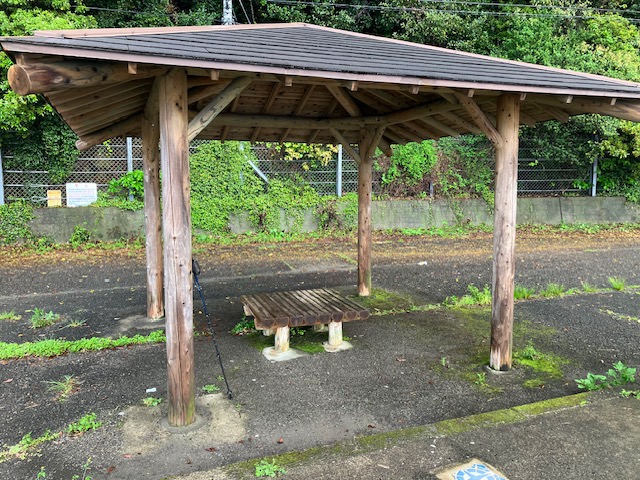
Day 10 - April 25 (28km)
There was no Tsunami to wash me away during the night, but the inside of my tent was still a bit damp when I awoke. And apparently, unlike lakes, the ocean doesn't calm down at night. Or at least around here it doesn't. Regardless, I wiped down the inside of the tent and dried out the fly a bit before leaving around 6:00. Unlike the past two days, the sky was clear of clouds.
An older married couple made me lunch half an hour earlier than their usual opening time. Apparently their granddaughter had spent some time in Canada.
At the cape, the view from the cliff-side lighthouse was fantastic. Deep, clear blues from both the sky and sea. The temple, on the other hand, was fairly plain. Since their Shukubō was full, I headed back down the mountain to a cheap inn called "Kawasaki", where the owner was, shall we say, quite "honest" in her speech. She kindly informed me how much I stank and promptly drew a bath for me. There had been some mixup with my reservation (being forgotten), but it all turned out in the end.
Animals: 6 cats, 1 murder hornet
Post-trip Addendum:
At the temple I ran into Tomatsu-san again, an actual monk walking the pilgrimage in the traditional robes. I had met him the first time a day or two previously near the town of Mugi as we were both being poured on by the sky. He was trying to avoid inns as much as possible, which I assume is part of the training. Sophie was at the temple too, a french woman who I had also briefly met at Yakuōji (23) three days before.
Original Japanese:
どうやら津波は来なかったが起きた時にテント内は若干湿ってた。それと、海と云うのは 湖と違って夜になると静まる事はない。それかせめてここでは。ま、テントを拭いて乾か して極力早く出発した。六時頃だった。今日は見事に晴れた。昼食は営業時間のいつもより30分早 いと云うのに出してくれた夫婦が居て、孫がカナダに居たと言う。
岬の灯台から見た景色は素晴らしかった。寺の方は逆に普通だった。宿坊に入れないので 山から降りて、奥さんが正直者の「民宿川崎」で一泊。予約はどうやら忘れられたか、結 局泊まれたので結果的に良い。
動物:猫6・雀蜂1
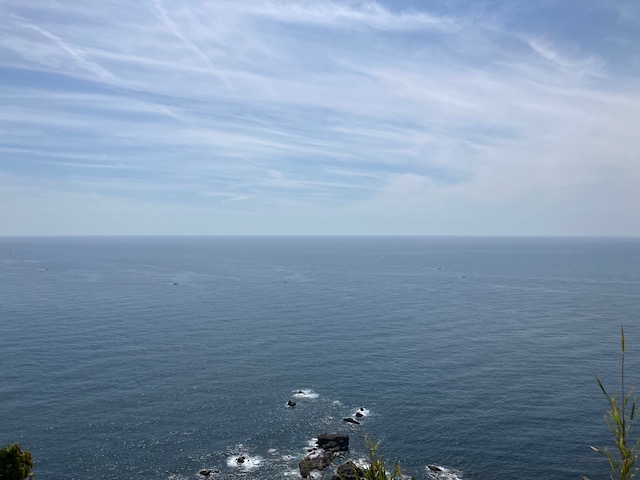
Day 11 - April 26 (25km)
I was up before 5:00 and out the door soon after. I didn't really want to interact with the owner anymore, and didn't have to since it was so early. The temple wasn't actually that far, so after scoping out its location I went and grabbed breakfast at a convenience store. After completing the temple routine, I killed some time reading a book while waiting for the Nōkyō office to open.
The climb up to Kongōchōji (26) wasn't bad at all. After that it was just another long walk. Hours later, just short of my lodging for the night, it decided to start drizzling. The town, Nahari, was otherwise nice.
You'd think my feet would be impervious by this point, but a blister on my right heel has suddenly worsened and walking is becoming painful. I think tomorrow is going to be a rest day, just in case.
Animals: 1 cat
Osettai: Mochi, gum, tea
Post-trip Addendum:
I was actually worried that I would have some critical foot issue and would have to halt the pilgrimage, but that never happened. By this point I was used to dealing with blisters, so I was surprised at this one. As a full-time walker, you have no choice but to drain blisters when they form. I always did so with scissors from my multitool, some disinfectant, and bandages. This nasty guy required a somewhat deep cut to get at the liquid, and what came out was an oddly red-tinged yellow (and a good amount of it). Fortunately, that was the second last blister of the entire route.
I haven't mentioned food much, but breakfasts at convenience stores were a fairly regular occurance. What else is open that early?
Original Japanese:
五時前に起きてすぐに出た。寺は比較的近かった為、まずコンビニに寄って朝食を済ませ た。それから本を読みながら寺の納経所の前で時間を潰した。
金剛頂寺までの登山もつらくなかった。それから只長い歩きだった。宿に近づいたら丁度 雨が軽く降ってきた。奈半利は良い町だ。なぜか右足のマメが悪化して明日また休息日を 取ろうかなと考え中。
動物:猫1
お接待:餅・ガム・茶
Day 12 - April 27
A full rest day to see how much my blister heals. The graves of the "23 Warriors" were at a temple nearby, so I checked that out.
For lunch, the owner of the inn took me to a famous ramen place nearby. The put the biggest lump of butter in there I've ever seen in a ramen. Man was it good.
Osettai: Onigiri, lodging
Post-trip Addendum:
The 23 Warriors had been executed somewhat unceremoniously after a pseudo-cout back in the 1800s. A farewell poem that the wife of the leader wrote after he died is carved into a pillar by the graves. Overall there was a lot of upheaval in Japan at the time, and as we know, the modernizers won out.
Bless the owner, she only charged me for dinner on the second day and not the housing itself. Since we were also on the cusp of Golden Week, she told me that if I couldn't manage to find something in the Kōchi City area over the next few days that I could hop on a train and come back to her place, again for free.
Original Japanese:
休足日。二十三士の墓のある寺に行って見た。昼食は有名なラーメン屋に一緒に連れて行っ てもらった。
お接待:お握り・宿泊

Day 13 - April 28 (32km)
Thanks to my day off yesterday I felt fresh and kept a great pace. The climb up to Kōnomineji (27) was a breeze, even with my pack. Once back down, my feet just kept carrying me forward, and before I knew it I was in Aki City. It was about noon and starting to get hot. I wanted to hit the nearest Onsen, but as I walked up to it I saw it opens at 15:00. No way I'm waiting around for 3 hours. I opted for a break instead and settled down on a nearby bench.
A tsunami siren blared through the air. I rushed to get my shoes back on to flee for safety... when the alarm stopped. I looked around. The locals were going about their day as if nothing had happened. I glanced at my watch: 12 noon. Feeling a bit embarassed I sat back down and resumed my break.
Oh and by the way: I was wrong about the sea the other day. It does actually calm down at night when the weather is good.
Close to the beach near Wajiki station I found a great hut with a bathroom. Home sweet home.
Animals: 5 cats, 1 snake
Post-trip Addendum:
Most (all?) places in Japan play a song over public loud speakers at 17:00. It's a signal that the day is (supposed to be) over and that's it's time to go home. Some smaller places will also broadcast something at noon, and Aki in particular decided to reuse their tsunami alarm for this purpose. The Japanese culture is used to having deafeningly loud sounds blast through the air from time to time. I assume it's a leftover from the air-raid sirens of World War 2.
Original Japanese:
休足日のお陰で朝から絶好調で飛ばせた。神峯寺への登山は荷物を背負っても割と楽だっ た。下ってからも足がどんどん俺を前へと運び、気づいたら安芸市内に居て大体正午。温 泉に入ろうとしたが三時営業。そんな三時間も待てん。
その時、津波警報が鳴った。慌てて靴を履き直そうとしたら警報が急に止んだ。よく見る と、周りの人間は平常に居る。腕時計を見て、何や、ただの正午のあれか。休憩続行。
別件だが数日前の海の事は間違っていた。ちゃんと静まる事はある。
和食駅の近くの浜辺付近に良い東屋を見つけたので宿にする。
動物:猫5・蛇1
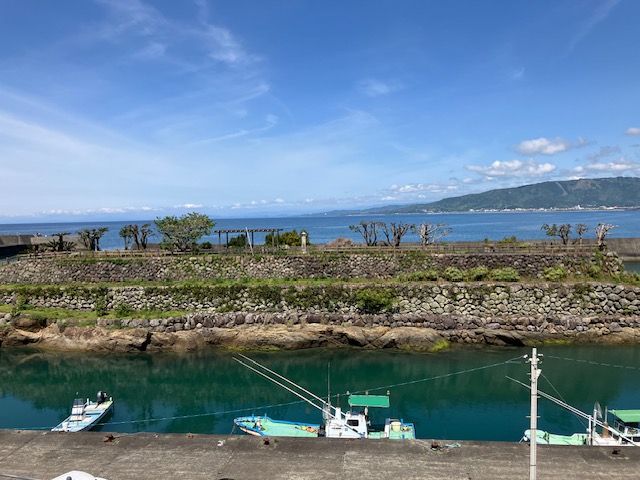
Day 14 - April 29 (24km)
The rain waited until I got to Dainichiji (28) but it hasn't stopped since then. A henro hut is the best I can do for lodging today, but at least it's a nice one. There is an Onsen only 2km away, so I passed the afternoon there and had dinner before trudging back through the rain to the hut. Luckily no one had claimed it in the interim.
Animals: 3 cats, 1 suppon, 4 white sagi
Post-trip Addendum:
I had only packed one small towel, which I unfortunately lost somewhere around Miroto cape. It must have fallen while I was walk-drying it. Nagaoka Onsen, where I spent the afternoon, had some for sale so I picked one up. That guy lasted the rest of the pilgrimage, and he's currently safe in the closet of my Tokyo apartment. Every time I pulled him out during the trip I remembered how Nagaoka Onsen had come through for me that rainy day.
Original Japanese:
大日寺まで雨が待ってくれた。それから止んでいない。昼頃に泊まりの小屋に着いた。午 後は温泉行って雨宿り。
動物:猫3・鼈1・白鷺4
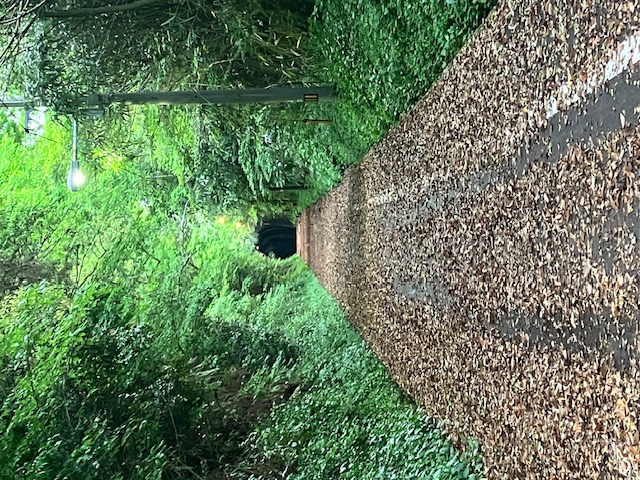
Day 15 - April 30 (19km)
As long as my tent is under a roof I can sleep without the fly on. The tent itself won't get wet, and I stay cool during the night.
I reached Kokubunji (29) almost right away, and the rain let up just then. The sun peaked through the clouds, and with no one else around, I had a few minutes of peace in the quiet temple grounds. Of the temple itself I can only say that "they're doing it right". Some temples don't try that hard or don't "look the part", but this one does. I'd say #2 after Tairyūji in terms of atmosphere.
By the afternoon I was in Kōchi City proper and ready for some sightseeing. I swung by the castle, watched some old guys play Shōgi, and rewarded my recent efforts with some celebratory Yakiniku.
Animals: 8 sagi, 3 cats
Post-trip Addendum:
There are 4 temples named "Kokubunji" in Shikoku, and this was the second one. There is one in each prefecture, as was mandated by the emperor in the 700s.
I had never been to Kōchi prefecture before this, let alone the city of the same name, so coming this far was another victory.
Apart from the Yakiniku I also made a trip to the local Mont Bell, an outdoor goods store. I picked up some "casual socks" and convinced another customer to buy the very socks I was wearing, my invincible, form-fitting pair.
Original Japanese:
雨が降っても、屋根があれば fly 無しでもテント内は濡れない。これで涼しいまま寝れ る。歩き出したらすぐに国分寺に着いて雨も止んでくれた。この寺はとにかく静かで綺麗。 よく「お寺」をやっている。太龍寺の次に雰囲気がよかった。
昼からは高知市内で観光。城を見て来て、夕飯はお疲れ様焼肉。
動物:鷺8・猫3
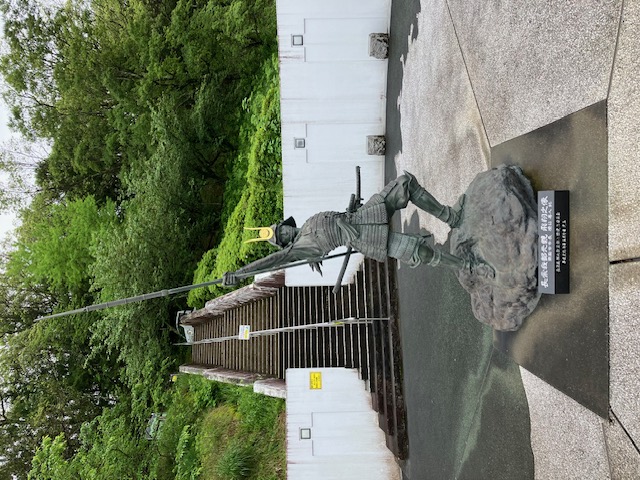
Day 16 - May 1 (35km)
It was truly raining right from the get-go this morning, and I was angry about it. The weatherman had betrayed me, and my right shoulder was oddly in pain. Chikurinji (31) and Zenjibuji (32) were both mountain climbs I hadn't expected, which irritated me further. There were apparently interesting special exhibits on at Chikurinji, but the rain and my schedule urged me onward. I took the hard way down and the rough, stony trail was quite slippery, but it didn't kill me and I enjoyed the victory despite being soaked.
At the ferry terminal, I met a woman who had moved from Tōkyō to Hokkaidō and loved it there. Apparently of all her travels, she found it the most beautiful. Were I to go, what would I need? And what about timing?
I had counted on being able to stay at Tanemaji (34), but was turned away. It was still too early in the day for them to permit people into the Tsūyadō. In a rush I called around the area and found a place with an opening about an hour up the road. I was lucky; that place filled up too immediately after that, and was actually over-booked.
Animals: Tons of crab, several sagi.
Post-trip Addendum:
It was this day that changed my mind about Calorie Mate. My emergency bar saved me in an area by the coast where there was just nothing to eat in the afternoon, no shops, no cafés, no convenience stores. At some point I pulled off out of the rain, and under someone's eaves downed the four small shortcake bars. 400 calories. Nothing much in them but flour and butter, but hey, it saved my afternoon mood.
I say "ferry terminal" but it was a very small, free one provided by the city. The trip was about 5 minutes, but saved probably an hour of walking.
If you're going to stay in a Tsūyadō, arrive at the temple past 16:00 or so. Otherwise they're going to tell you that you still have time to make progress and shoo you out.
Original Japanese:
朝から強目の雨が降ってきてそろそろ怒った。右肩も妙に痛い。竹林寺も禅師峰寺も思わ ぬ登山だったから更にいらいらした。竹林寺は色々と展示していたらしいけどまだ早かっ たし雨だったので先へ進んだ。
Ferry の乗り場で東京から北海道に移住した人と会った。日本各地を廻ってやはり北海道 、と。俺も行こうと思ったら何が必要?タイミングは?
頼りにしていた種間寺は宿泊だめと言われて慌てて宿を探した。一時間先に空いている所 があって助かった。
動物:蟹、多数・鷺、複数
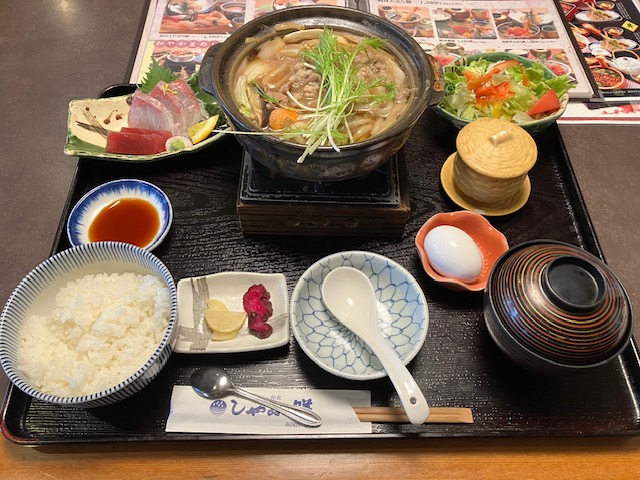
Day 17 - May 2 (26km)
I didn't sleep well and was already walking by 5:30.
The temple, Kiyotakiji (35), was nice. It was a 100m or so climb from the valley to the temple, and the view down on Tosa City was fantastic.
Once in Usa I found the lodging situation to be... not good. Another temple full, as were all the surrounding inns. There were two ways forward, and at the temple's suggestion I avoided the highway and retraced my steps back over the big bridge and headed up the coast that way. It's the "long way around" but there's a short ferry you can take in between. Apparently Kūkai did it that way too, so it's not cheating. That'll be tomorrow.
The sun was wanting to set as I took a short break by a small, roadside shop. An old lady came out and gave me some citrus fruit and something deepfried. They were both delicious, although the fruit was filled with seeds. This is real life, I thought to myself.
A bit past that I found the inn "Nazuna", a place that had been recommended to me before but I knew was full. I asked if they knew anywhere I could throw my tent down for the night, and they offered to let me pitch it in their driveway for a fee. Another lucky night!
Animals: 20, yes 20, cats
Osettai: Bread, citrus fruit, something deepfried, snacks, tea
Original Japanese:
よく眠れなかった。五時半までにもう歩いていた。
寺自体はよかった。清瀧寺からの土佐の朝の景色は特に感動的だった。宇佐に出ると宿は 全滅状態。寺から引き返して海沿いを歩いていると、ある商店で小休みをして中のお婆ちゃ んが出て来て小夏など色々とくれた。小夏には種が沢山入っていたが甘かった。人生だな と思った。その先の満室のはずの「なずな」で近くにテント張れる所ないかと尋ねていた らここで良いよとなった。明日は船。
動物:猫20
お接待:パン・小夏・揚げ物・菓子・茶
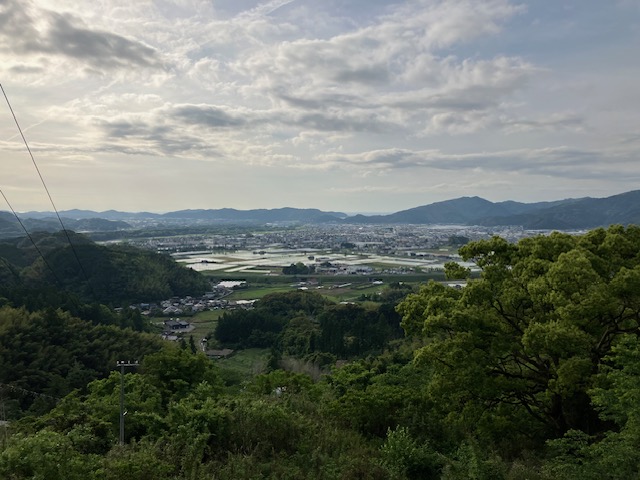
Day 18 - May 3 (32km)
After what I wrote last night, the owners of the inn called me into the house and fed me a bit more, which they weren't at all obligated to do. I got a chance to chat with the other guests, who apparently had made their booking months ago.
At some point past midnight, I was woken by a sound near the garbage cans. Something was in a tree. I got out of my tent and shone a light at it, and golden, twirling eyes stared back at me. A demon monkey from hell, I concluded, but we agreed that I'd get back in my tent if he agreed not to come down and feast on my soul.
The next morning I waited and waited at the small ferry terminal, but no boat ever came. A careful inspection of the small, posted schedule stated "no service on holidays". It was a Friday, but technically still Golden Week, so that must have been it. While I was waiting I had read a lot and made some great personal discoveries, so the time was fruitful after all. Maybe a gift, even.
I had no choice but to press on on foot. Tonight's lodging is a henro hut at the foot of my next mountain climb.
Animals: 3 cats, 1 mamushi
Osettai: a morning Bentō, citrus
Post-trip Addendum:
This was also the day I visited Bekkaku 5, Daizenji.
Original Japanese:
昨夜、あの後お接待で簡単ながら第二晩ご飯を出された。夜中、近くのビワの木から音が して光を照らしたら金色の出玉がこちらを睨んでくる。猿だろう。
今日念願の Ferry は運休なのか、待ったのに来なかった。その間代わりに本を読んだの で完全時間の無駄ではなかった。仕方なく歩き出すのみ。今夜は麓の小屋で寝る。
動物:猫3・蝮1
お接待:朝弁当・小夏
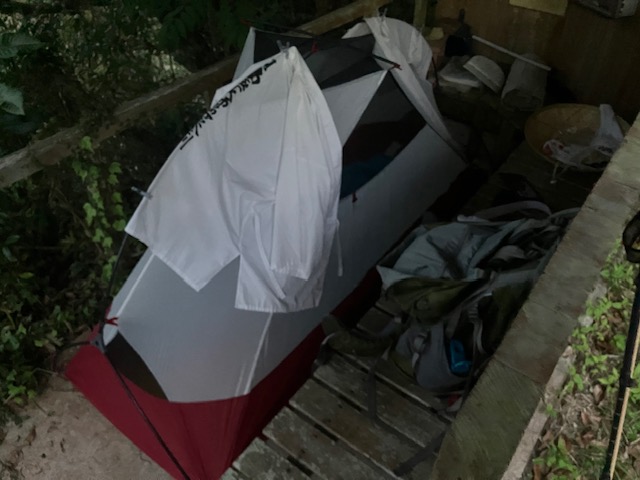
Day 19 - May 4 (32km)
Last night I caught a monster spider hanging out on the hut wall near my tent, but this morning she was no where to be seen. I began the mountain climb at 6:00, and other than the stair section at the beginning it was no trouble. Before I realized it I had already popped out onto the road again. It was a clear, blue morning.
In a small mountain town I found a café and ordered breakfast, which one of the other patrons paid for. She also gave me her hard-boiled egg as she and the other old ladies peppered me with questions. Later, around noon, as I was walking the highway again she appeared in her car and handed me lunch, fruit, and some tea. I was shocked by both her kindness and her effort. Thank you, truly.
Iwamotoji (37) was another "well done" temple. The surrounding town is called Kubokawa and I found it quite a lively place. I'll admit that some part of me is also scoping out Shikoku for potential places to live, should I ever decide to move here.
Apparently there were no bath houses in the area, so I had no choice but to move on. I'm at another Henro Hut tonight, sandwiched by a roadway and river. Tomorrow I'll finally reach Tosa Saga.
Animals: 1 mamushi
Osettai: Breakfast, candies, tea, onigiri, fruit, etc.
Post-trip Addendum:
Through some smaller mountain pass I found myself on a thin trail cut out of the ground in the shape of a halfpipe. Lying in the middle was a mamushi, the deadliest snake in Japan. Poking the ground with my staff got him moving, but he couldn't make it all the way up the steep wall of the trail and kept falling back down. Eventually I took as wide of a berth around him as I could manage and just ran past. He didn't follow. Adrenaline surged through my body and I felt like I had passed a test.
Original Japanese:
昨夜の化け蜘蛛は見当たらん。六時登山開始。最初の階段以外は簡単だった。気付くとも う県道に出ている。
ある小さな町のカフェでモーニングを注文すると、別のおばさんが払ってくれた。昼頃に また同じ人が車で現れて弁当や果物を差し出す。有り難うございました。
岩本寺もまたよく「お寺」をやっている。町の名前は窪川で中々活気のある所だと思った。 生憎お風呂らしい所は近くにないと云う。よって今日も遍路小屋を頼りにに晩を過ごす。 明日早朝からやっと土佐佐賀!
動物:蝮1
お接待:朝ご飯・飴・茶・お握り・果物など
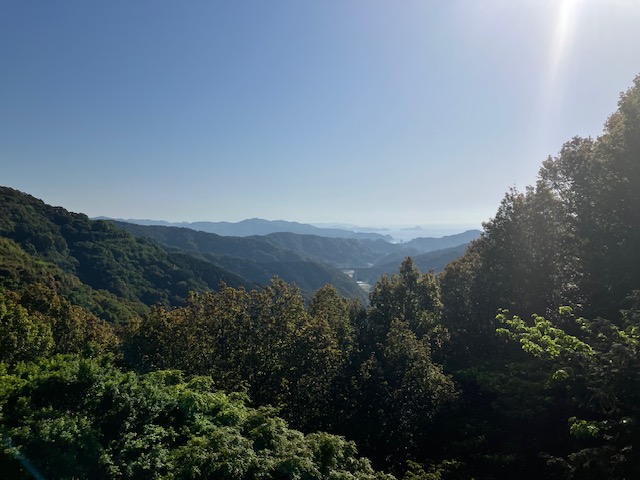
Day 20 - May 5 (23km)
It was a straightforward day. I set off at 6, and after two hours found myself in Tosa Saga. After feasting on some Katsuo-tataki at a Michi-no-eki, I took a video of the surroundings for Wataru and the guys.
I got a bit lost on a mountain path, but soon found my way back out again.
After walking for ages I finally reached the outskirts of Shimanto City. Tonight I'll be staying at a campsite for surfers. A few of them came over to talk to me, and pretty soon they were sharing their BBQ with me. We had some good conversations. One in particular was memorable; the young owner of a local fertilizer company and I discussed the relationship between big cities like Tōkyō and the countryside. From his perspective, he's grateful to the cities for creating a market for the countryside to sell to.
Apropos nothing, I had the feeling that I need more control over my time.
Animals: 10 sagi
Osettai: Meat, mochi, tea
Post-trip Addendum:
I hadn't bathed in four days. The campsite had a coin-operated shower, but 5-minutes max, cold water only. It's meant for the surfers to wash sand off themselves. As I stood naked in the stall with the coin in my hand, I thought "it's this or being dirty for another day". I put the coin in... and it was fine. The cold-water baths you find in Onsens are colder. Humans aren't weak.
The town of Tosa Saga was a joke-milestone, as I used to live in Saga City in Kyūshū. Wataru is a friend from that era who I still meet up with in Tōkyō.
Original Japanese:
割と分かりやすい一日だった。六時出発で二時間歩くと土佐佐賀に到着した。道の駅で鰹 たたき定食を食べた後、亘らの為に町の動画を撮った。
山でも少し迷ったな。
ずっと歩いて四万十市を目の前に今日は surfers がよく通うキャンプ場で寝る。話し掛 けられて地元の人々と色々喋った。特に、肥料を作っている会社の若手社長 surfer と、 都会と田舎の関係について語った。もっと、自分の時間を自由に操れる状況を作らないと。
動物:鷺10
お接待:肉・餅・茶
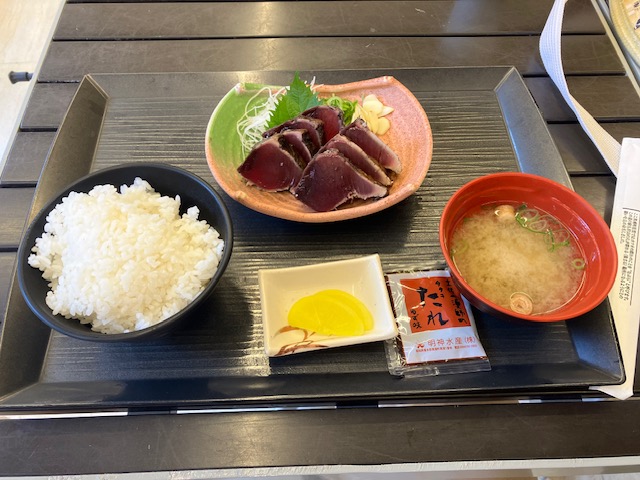
Day 21 - May 6 (25km)
It was another night in the tent, and the surfers had warned me it was supposed to rain overnight. Would this be my first morning packing up a wet tent?
My eyes popped open at 3:45. I felt around and realized it hadn't started raining yet. "No time like the present" - I jumped out of the tent, packed up with the fear it could pour at any moment, and headed off into the predawn darkness. Never have I walked in such blackness. To my left was the sea, to my right the woods. I pressed on like this for a few kilometers, when it occured to me that I was alive. Nothing had sprang out and eaten me, so I rightly concluded that werewolves don't in fact exist. I glanced up at the moon anyway.
Around 8 I found a small countryside Udon restaurant, somehow open, and I had Tantan Udon. Not much further past that it finally started to rain, and rain it did. I reached today's lodging, "Anjuku", by noon, and it was truly pouring. The wind had been in my direction the full length of the valley, so I was quite wet despite all my protection. Luckily I've already booked tomorrow's lodging, and it isn't supposed to rain.
Animals: Many sagi, many mountain frogs
Osettai: candies
Post-trip Addendum:
The early-morning walk through the darkness was one of my favourite moments of the pilgrimage.
Original Japanese:
三時四十五分に目が覚めた。夜中に雨が降らなかった事に気づき、敢えて起きてテントを 速く畳んでその場を後にした。周りは真っ暗。左側を海に、右側を暗黒の森にして何粁か 歩いた。途中で食われなかったのでやはり狼男は存在しないと結論。
八時頃に田舎うどん屋で担々うどんを食べた。その少し後に雨がやっと降り出した。どん どん強くなる。昼頃に今日の宿に到着。「安宿」と云う。荷物はまあまあ濡れている。幸 い明日も岬の方で宿を取り、雨も降らん(はず)。
動物:鷺、多数・山蛙、多数
お接待:飴
Day 22 - May 7 (26km)
The path to the cape and back up is varied. There are two ways down and around four ways back up. The wife of the inn owner suggested that I avoid the coast today and instead head through Shimizu City, looping back down and around to the cape. That way, I'll maximize variety and be able to walk back up the eastern coast properly tomorrow morning.
There was another reason to go through Shimizu instead: food. The eastern coast has very little along it besides small fishing villages. In Shimizu I found a café and had brunch around 9:30. And man, the long beach at Ōki was fantastic. I walked the whole length of it and took a break on the sand. I gazed at the sea and felt peace. I wondered when sand first came to be, and thought to ask my sister.
The temple, Kongōfukuji (38), was a spectacle. Another very "well done" temple. The main gate was beautiful, and the statues all around make Shingon seem a little truer. Maybe.
Tomorrow it's about time I really did some distance. Now that I'm at the second cape, the journey is about half over. The day after tomorrow I'll be out of Kōchi and into Ehime, the next stage of the training. Kōchi was long but not overwhelming. Sure I got rained on and had to sleep outside for a few days in a row, but never once did I think of quitting.
Animals: 1 cat
Osettai: Nigiri, candies, some extra dinner
Post-trip Addendum:
The real reason I wanted to go faster was because I got a message from Jeffery (remember him?). He was somehow already in the 40s, several full walking days ahead of me. Even accounting for the day I rested, he still must have been really pushing every day. This made me feel somehow behind, despite the locals telling me I was going at a good pace.
I'm reminded of the words of a old lady at a particular temple:
It doesn't matter what other people are doing. The Henro Path is exactly the path you chose to walk.
Original Japanese:
安宿の奥さんのお勧めで清水市経由で岬に向かった。お陰でモーニングも九時半頃に食べ れた。「大岐」の浜辺もよかったな。休憩を取って砂の上に座り海を眺めた。砂はいつか ら出来たんだろうと今度妹に訊いてみようと思った。
寺自体はこれもまたよく「お寺」をやっている。山門は綺麗だった。沢山の仏像からも真 言の魅力を感じた。
明日はそろそろ距離的に頑張らんといかん。今日で気持ち的にもう旅が半分終わっている。 明後日から愛媛で「修行の道場」を後にする。高知は、それ程つらくなかった。雨もあっ て一時期野宿は相次いだが諦めようと一度も思わんかった。
動物:猫1
お接待:握り・菓子・夕食の足し
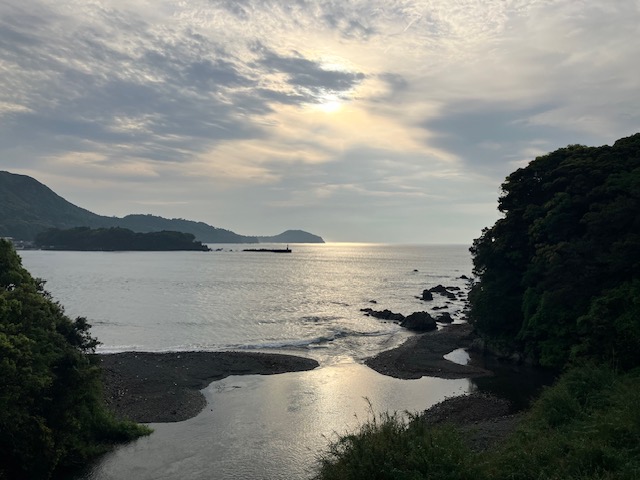
Day 23 - May 8 (47km)
Today I got a glimpse of my limits. At the moment I'm set up for the evening at a large dam in the mountains. I left the cape at 5:30 this morning and headed back up the eastern cost. The weather was perfect. Back near the long beach a local told me not to treck down the rockier path, since the rain had washed out the usual sand bridge. I went anyway and jumped the tiny river that had formed. No issue.
By 10:30 I was back at the inn from the previous day and grabbed a quick lunch. That's already a good 20km walk. There, I talked with the owner about my options for the evening. I was thinking about heading for a campsite a few hours up the road. He suggested I instead go another 10+ km further than that to a dam, saying there's a park there where I could sleep wherever I want.
I'll get to the campsite first and then weigh my options.
By 15:00 I was at the campsite. The road to it peeled off from the main road and wound down to the riverside. There wasn't a soul in sight. Furthermore, I had no water. None even for drinking, let alone cooking. I had drank it all working my way up the narrow yet scenic mountain road. There were outdoor taps here, but no way to know where they draw from. I checked my map again. Another few kilometers to Mihara, and then another handful more after that to the dam. It was only 15:00...
I got to the dam just past 18:00. I was active for a full 12 hours today. And you know what? I was in pretty good shape. Nowhere near as beaten up as I thought I'd be. I had pasta for dinner, alone(?) in the mountains.
Animals: 3 cats, 2 snakes, 4 "badgers"
Osettai: Citrus, nigiri, candies
Post-trip Addendum:
This was the furthest I ever walked in one day. I thought to myself at the time "I could have gone 50", which means if I really needed to push it or someone's life was on the line, who knows how far I could go?
As I was setting up my tent, a gray van rolled slowly by. I couldn't see in the windows; the van was filled with trash and belongings. The nearby dam had a control building where employees must be during the day, and I had noticed a number of cars in its parking lot, and yet the building itself seemed dark. My guess was that the cars actually belonged to nomads, just one step away from homelessness.
Original Japanese:
頑張った日。今、山中のダムの所に居る。三原キャンプ場はなぜか気に入らなくて(誰も 居ない、水飲めるか怪しい)先へ進む事にした。ただしこの時点で水がない。三原まで辿 るしかない。そしてそこからダムまでは後一時間だけなのでやり抜く事した。丸十二時間 の活動。でも出来た。そしてそんなにボロボロではない。
剣道21号の参道は結構好きだった。まるでまたBCに居る。三原村自体も割と活き活きし ている。良い町だ。
後述:出発五時半頃、安宿に到着十時半頃、分岐に近い十二時頃、camp場を去る三時頃、 ダムに到着六時過ぎ。
動物:猫3・蛇2・Badger4
お接待:小夏・握り・飴
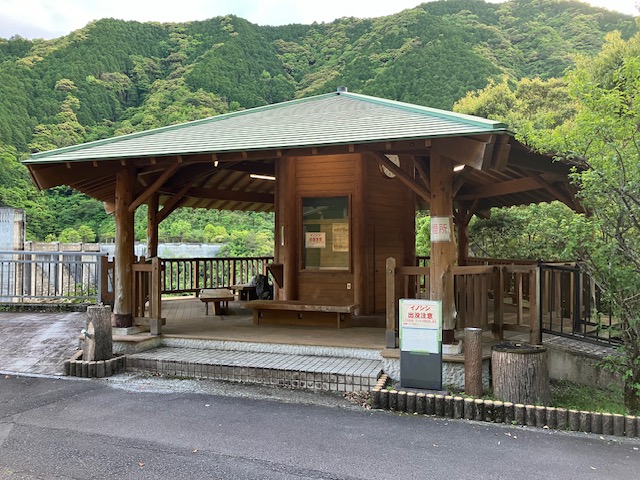
Ehime Prefecture - Awakening
Day 24 - May 9 (33km)
The murder van from last night rolled slowly by again at 5:20 this morning. Filled with trash I couldn't see the driver. What kind of life could that be? So I was neither murdered nor was I eaten by the wild boar that nearby signs warned me of.
The grounds of Enkōji (39) weren't very large, but it was quite clean. It was a really peaceful morning. After that it wasn't far to the prefectural border, and I finally, finally left Kōchi and entered Ehime. Come to think of it, it's been 12 days since I last rested and my feet are starting to hurt. Yesterday was also quite the haul.
I reached Kanjizaiji (40) around 15:00. I ran into Sophie again, and also bought a new bandana with the Kannon Sutra printed on it. Something of a good luck charm.
My lodging for the night was perhaps another kilometer up the road. The old lady had been running it for 50 years. She took me to dinner at a local place and she told me about her life. She's 79. She lost her husband to alcohol 26 years ago, but she has her kids around for support. Her husband was a fisherman.
Animals: 3 cats, 1 snake
Osettai: extra dinner, a discount at the inn
Post-trip Addendum:
That was the last I saw of Sophie. She told me that she'd be zipping ahead the next day by bus, since she was a bit behind schedule and there isn't a temple for another 2 or 3 walking days.
Hiking through the border mountains I met Agatha for the first time, a German graphic designer. She'll come up again in a few weeks.
Whenever I was afraid I would chant the middle section of the Kannon Sutra from memory. It describes terrible situations a person can find themselves in (being thrown off mountains, dunked into lava pits, surrounded by demons, etc.) and how that danger can be cast off by 念彼観音力, roughly put into English as "thinking on / believing in the power of Kannon". That sounds like spiritual, faith-based belief that someone used to the notions of Christianity might assume, but there are varying interpretations. I chose to interpret it meaning "my inner potential" as a human being, an on-going theme of my pilgrimage. And it actually works. I chanted it through every car tunnel I walked through (there were many). It still works now, even back home.
Original Japanese:
昨夜目撃した殺人バンは今朝の五時二十分頃にまたゆっくりと通って行った。ゴミで一杯 で運転手が見えん。どう云う人生だろうか。あとどうやら猪も現れていない。
延光寺は境内がそれ程広くなかったが清潔の意味で綺麗だった。平和な朝だった。それか らひたすら歩いた。そして松尾峠を超えてやっと愛媛に入った。
そろそろ足が痛い。昨日のせいか。寺には三時頃に着いた。そこでまたフランスの Sophie と会った。日和佐から時々会う人。宿のお婆ちゃんが五十年も宿をやっていると 言って一緒に夜ご飯を食べに行った。七十九歳。夫は飲みすぎて二十六年前になくなって いる。漁師だった。
動物:猫3・蛇1
お接待:晩ご飯の量・宿代の割引
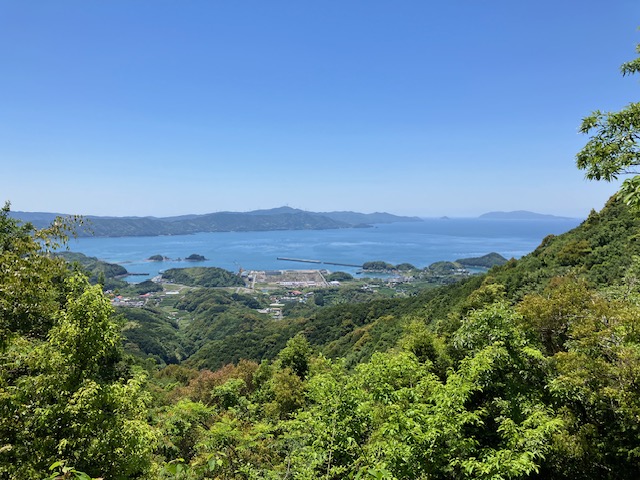
Day 25 - May 10
I took today off. I was the only one staying at the inn (a house, really), and the owner wanted to show me her town. She drove me up a hill and we visited the museum of the "Shidenkō", a fighter plane from World War 2. This particular one had been shot down and crashed into the water nearby the town, and was rediscovered by a diver and lifted out to great fanfare about 50 years ago. The owner and her family watched it happen. Six fighters failed to return during that particular battle, and this was thought to be one of them. Of the six missing pilots, only one was married, and he had a newly born daughter. Reading the testimonies of surviving family members moved me. They weren't bad people.
Tomorrow I will walk as far as Bekkaku #6.
Post-trip Addendum:
I had a realization about Blame. "Fault" implies both cause and responsibility for fixing. Think of a traffic accident. If you are "at fault", you are both the primary cause of the issue, and the one to pay for damages. This is the legal definition of Fault. But, between people, I think cause and responsibility must be split. Yes, others may have been the cause of some trauma I experienced in my past, but it remains my responsibility to fix it.
"To blame" means "to apply fault".
If you assume that cause and responsibility are linked into "fault", you can get stuck because:
- You may be unable to "collect on the debt" because:
- The person is dead.
- It's been a very long time since the incident.
- It's impractical to "ligitate" because they live far way, etc.
- It may not be clear who the causer even is.
- Collecting on the debt may not heal the damage anyway.
- You are stuck in victim mode and can't mature.
So, it's up to you.
Original Japanese:
休足日。近くの「紫電改」資料館に車で連れて行ってもらって、大戦の時に墜落して五十 年程前に海から引き揚げられた戦闘機を見た。零式と違いこれは「局地」型と云って陸の 方から飛ぶ。この機体はある戦いから帰って来なかった六機の内一つと見られている。六 人のパイロットは居て、その内一人が結婚して娘が生まれたばかりの時に彼が死んだ。証 言を読んで感動した。
明日は別格六番まで歩く。
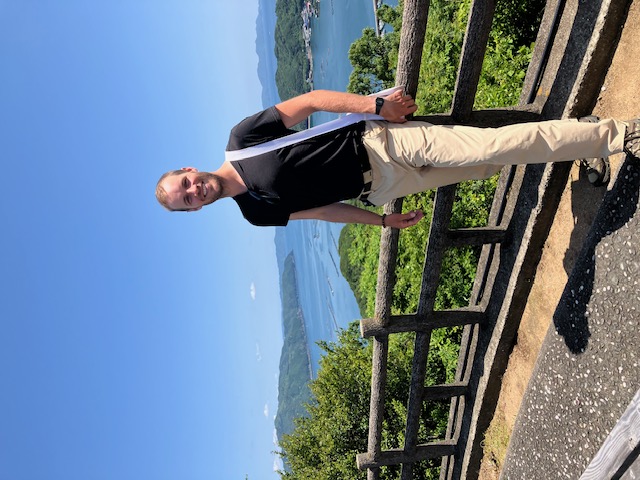
Day 26 - May 11 (38km)
Today I had to reach Bekkaku 6 before it closed, so I was gone by 5:00. Tetsuko-san woke up as well and saw me off, waving as I disappeared down the road. I arrived at the foot of the mountain pass around 7:00, and the hike took 3 hours. No problem at all with my feet.
I reached Uwajima by 16:00 or so, still plenty of time to visit the temple. Their cemetary was impressive in scale, and the lady at the Nōkyō office was friendly.
The inn I stayed at had been renovated from an old house by a young couple. Apparently their wedding had been a "hitchhike wedding" where they did a once-around of the whole country. I ask myself why I don't get these kinds of ideas. I need to dream bigger.
Animals: 4 cats, 1 snake
Original Japanese:
五時頃出発。徹子さんが起きて見送ってくれた。七時前に登山口に着いて登下山は三時間 掛かった。足には問題ない。
宿の若い夫婦がここを古い家から改装して二人で営んでいる。その結婚式も何と hitchhike wedding であって日本を一周した。自分にはこういう発送がないのはなぜだろ う。 Dream bigger Colin!
動物:猫4・蛇1
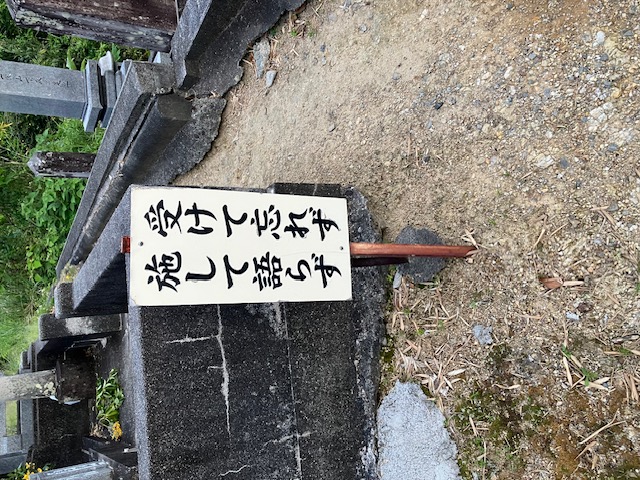
Receive and forget not; give and boast not.
Day 27 - May 12 (28km)
A day of rain. By 11:00 it was truly pouring and I was soaked long before I ever reached my hotel. My boots, as excellent as they are, couldn't stay dry and I had a few hours of that soggy-shoe feeling.
Dinner was a buffet, and Sumō was on TV.
Post-trip Addendum:
I got lost trying to find the temple and went way up a hill I didn't need to. I popped out near a giant museum, walked in with rainwater rolling off me, and asked where the hell the temple was. They pointed me back down the hill. Ho boy did I ever give that bell a ring when I got there.
Original Japanese:
雨の日。十一時頃から本降りになり宿に着くまでにかなり濡れた、特に靴。晩はホテルで buffet。相撲も放送されていた。
Day 28 - May 13 (26km)
It was still raining this morning but the route demands progress.
The climb up to Shussekiji (Bekkaku 7) didn't take as long as I thought it would, and it was quite peaceful. I felt like the only human on the mountain. There were some tricky sections, but that made it fun. I was there by 14:00 or so, and the view from the top was stunning. A temple sat upon a mountain peak.
When I get home I won't be pursuing KanjiNet. I'm going to move on to Big Sky directly. That's what I want.
Post-trip Addendum:
Shussekiji, while a Bekkaku, is massive and gets many visitors. Only a few were there while I was, but you could tell it's a frequented location, despite not being part of the main 88. This was the only temple on the entire pilgrimage that I was able to stay at officially. My room was quite spacious and the shared bath was surprisingly modern. I had to cook for myself though, and boiled my pasta noodles over by the temple gate with the Guardian Statues peering down over me.
Big Sky is my next major software project, after I release Aura 4. Stay tuned.
Original Japanese:
朝はまだ雨だったが出発するしかなかった。出石寺への登山は静かで平和だった。その頃 雨も止んでいた。寺は山頂に在り景色が相当な物。
やはり帰ったら漢字ネットじゃなくて直接 BigSky に移る。 That's what I want.
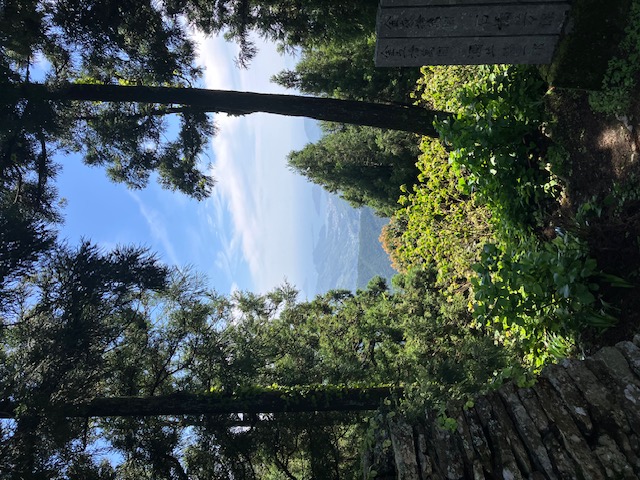
Day 29 - May 14 (26km)
I was told the morning devotion would start at 6:00, but the time came and went and the temple was silent. At 7:30 the Abbot emerged in a tizzy and whisked us off to the Fire Hall, the Grand Hall, and the Master's Hall, where we participated in the rituals. Despite the late start it was a rare experience and I'm grateful for it. I will visit here again one day.
By 8:30 I was hiking back down through the trees. Most of the way down there was a section marked on the map as "difficult passage", and I found myself bush-whacking for a few minutes before I convinced myself I had taken a wrong turn. Down a different fork in the path (mostly blocked by construction equipment) I found some farmers who told me that I wasn't lost and just needed to squeeze through a tiny footpath between their fields and the hill to get back to the road.
By noon I was down into the city of Ōzu. Here was Toyo-ga-hashi (Bekkaku 8), the temple with the coolest name. It means "The Bridge of Ten Nights", referring to a legend of Kūkai where he slept under a nearby bridge for a night and pondered the nature of humanity. It was said his meditations felt like the passing of ten entire days, and the name came to be. Luckily the bridge is still there, and under it is a stone statue of Kūkai, lying on his side, fast asleep. It was a strange feeling to see him after all these weeks - I had lifted my staff over every bridge I crossed, and often questioned Kūkai out loud at his choice of nap locations.
Seriously Kū you're going to get ticks.
or
Look at this river! I bet you're soaked to the bone down there.
To which he would reply that he was swimming instead. Smart-ass always had an answer.
The next town, Uchiko, was charming. By complete coincidence I found a restaurant ran by a German guy and his Japanese wife and had an excellent dinner. We spoke in German as well, and he gave me advice about where to sleep that night. Apparently the park back on the other side of the river had free camping, which wasn't at all marked on my map. That's where I am tonight and there isn't a soul around. Tomorrow I hope to get to temple 45, but it's far.
Osettai: Mochi, salad, information, a strange citrus
Original Japanese:
朝の務めは六時からと言われたものの六時が過ぎても誰も現れない。結局七時半頃に住職 が慌てて出てきて、それから俺と彼ともう一人の女性旅人と護摩堂、本堂、大師堂での儀 式に参加した。とても良い経験だった。この寺をまた訪れたい。
下山は八時過ぎ開始で、高山道で下った。「通行困難」の所で藪で迷って引き返して近く の農家に道を尋ねた。大体昼前には大洲に入っていた。
十夜ヶ橋でやっと寝ている空海と会った。不思議な気持ちだった。
内子はとても良い町。偶然でドイツ人がやっている店を見つけてそこで晩を摂った。ドイ ツ語も喋れた。近くの広い公園の事も教えてくれて今日はここで無料で野宿。今日中にもっ と伸ばしたかったが先に進んでも当分は何もない。できれば明日で45番に辿りたい。
お接待:餅・サラダ・情報・妙な柑橘類
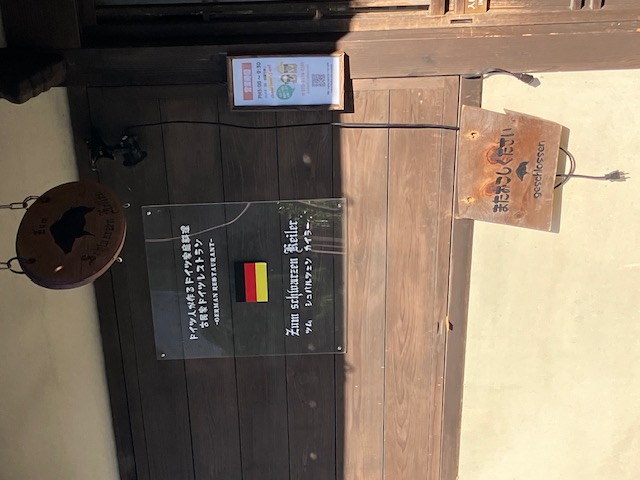
Day 30 - May 15 (44km)
I killed it again today. I was up at 4:30, gone by 5:00, and was on a tight schedule the entire day. It was non-stop walking, and a lot of it uphill.
At one point I hit another farmer's fence, which seemed to cut off the route entirely. I took the obvious detour, except it wasn't, and I found myself in the bush again. I turned around and quickly discovered that the fence had a little door which in my haste I had missed.
I really flew today. Heading for the Nōso Pass I walked 5km uphill on a mountain highway, finally passing through the flat Mayumi Tunnel. At the foot of the pass I was already mostly out of food but had to keep going. I did manage to get water from a local. Back uphill you come upon the ruins of Nakano village, and there isn't a soul in sight. This is several hundred meters above sea level in the middle of the mountains. They have a school up there too, but it clearly has not been used in decades. Their Jinja was quite large, but similarly looked unkept. After that the true climb began, with several poorly marked sections of trail, also highly overgrown. I was afraid to take this route because I knew that Nakano Shūhei, the author of a Henro book I had read, got lost here. But I decided I had to. In the end I made it through confidently and I don't know where he could've gotten lost.
This particular route is special because you descend upon temple 45 from the top, doing it before 44 to avoid backtracking. I arrived through the mountain gate at 16:15 (recall: they close at 17:00). Considering how far I had walked, that's amazing timing.
Another 3km down from the temple was a hut standing beside a hot spring and restaurant, unfortunately closed today. Which meant no real dinner, since all I had left was dried apples and Calorie Mate. At least there are drink machines and a bathroom here.
Can I make it to Matsuyama tomorrow?
Animals: 2 cats, 2 snakes
Post-trip Addendum:
This day was the greatest accomplishment of planning, mental fortitude, and physical execution of the entire pilgrimage. I walked from Uchiko to Iwayaji (45) in one day. That's almost unheard of, and had the conditions been any different I wouldn't have made it. Rain? Bad wind? Slightly slower pace? One break too many? Getting lost in the mountains? No path optimizations? Any of that and I wouldn't have made it. But I did.
The "unrecommended" route above Nakano village was probably also the most challenging of the pilgrimage in terms of execution difficulty. There were some very thin sections of trail, upon which a slip would mean a tumble down the hill. The trail itself was also very poorly marked in places.
Original Japanese:
また一日頑張った日。四時半起きで五時出発。ひたすら歩いた。ある場所で農家が道に柵 を張ってて避けようとまた藪の所に突っ込んた。すぐ通れんくなって引き返したら普通に 柵のドアを開けるべきだった事が分かった。
かなり飛ばした。農祖峠と槙の谷の道を通って行った。途中で水がなくなり近所の人に頼 んだ。中ノ村もあったがもう誰も居ない。古い小学校の校舎もあってようこんな高い所に 学校を建てたなと思った。村の神社も壮大やったがこれも最近触られていると思えない。 その先は本格的に山道になるが結局中野周平がどこで迷えたかは分からなかった。
寺に着いたのは四時十五分頃。三粁下山した所に東屋があり今日はここで野宿。明日から 松山?
動物:猫2・蛇2
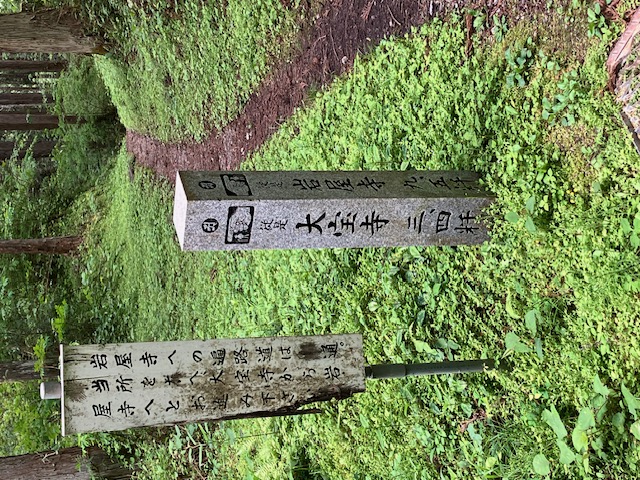
The pillar reads:
Left, Daihōji, 3.4km. Right, Iwayaji, 9.5km.
The sign reads:
The route to Iwayaji is not passable. Turn left here and visit Daihōji first.
No.
Day 31 - May 16 (30km)
The wind was fierce today, blowing directly into my path whichever angle I faced. After a humble breakfast I set out for temple 44, back in the direction of Kuma-no-Kōgen. The town itself was cooler, surrounded by mountains 500m above sea level. From there came another 200m rise through the Misaka Pass, and then a two-hour descent into the outskirts of Matsuyama.
I came to my lodging relatively early, so decided to dump my luggage, hit the three nearby temples, and return by the time the baths opened. The monk of Bekkaku 9 was a young, friendly man who gave me a charm for traffic safety. He had a cat hanging out in the Nōkyō office as well, which was a stray they had taken in. Yasakaji (47) has a rich history and is clearly well-loved by the locals. Jōruriji (46) is one of the few temples whose grounds are filled with trees.
During dinner at the inn I sat across from a young man who had injured a muscle in his leg by pushing himself too hard. He had started his pilgrimage 8 days after me and yet had caught up to me here, meaning he must have been repeating 30-40km days and not resting at all. Apparently he's now continuing his journey by bus, at least until his leg heals.
Animals: 3 cats, 1 baby boar
Osettai: A charm
Post-trip Addendum:
The only boar I saw on the journey was that little guy. On my way back from the temples I saw him standing in someone's driveway. I asked him "What the heck are you?" and he fled. I didn't see his mother around, which was better for me.
Original Japanese:
今日は異常に風が強かった。質素な朝食を食べて出発。道には上下が在ったが辛くなかっ た。
宿に比較的早く着き、先の寺を二つ打って来た。別格九番のお兄さん和尚は陽気だった。 寺で飼う捨て猫も納経所で寛いでいた。八坂寺は明らかに地域の支援を得て歴史もあり栄 えている。浄瑠璃寺は木が一杯で良かった。
宿で頑張り過ぎて足を「壊した」と言う若者と話した。気を付けよう。彼は四月二十四日 スタートで今日で同じ宿だから一切休まずに連続で三十四十の日を繰り出しとったろう。 今はバスで旅を続けていると言う。
動物:猫3・小猪1
お接待:守り
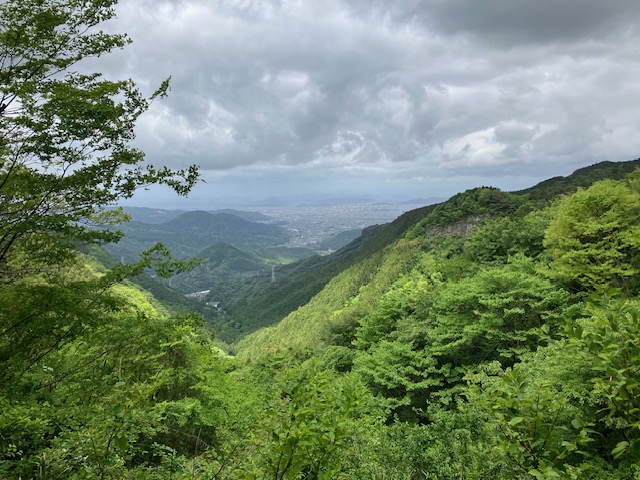
Day 32 - May 17 (23km)
I spent today in the City of Matsuyama. Of the temples, I can only recall Ishiteji (51). It had many halls and historical objects within its grounds, but was nearly overrun with tourists.
My Kindle is truly dead, so I sent its husk and a few other things back home as a parcel to myself. After that, just to gain some progress, I hiked across the city and then doubled back to the core (and my hotel) by train. I stopped by the famous Dōgo Onsen and the Mont-bell as well. I had wanted a massage too but couldn't find a place. I celebrated my arrival in the city with some all-you-can-eat Yakiniku, my first since Kōchi.
At some point in the afternoon I saw a stunningly beautiful woman on the tram. It was the aura, not just the looks. I wanted to talk to her but couldn't find the chance as I hauled all of my pilgrimage gear through the throng to get off at my stop. Off the tram, I turned back and she was smiling at me. Too bad, I'll never see her again.
Osettai: Juice, candy, 500 yen, a 50 yen discount, mochi.
Post-trip Addendum:
The point is not that I failed to talk to someone I thought was attractive, but that I let the situation (the chaos of getting off a packed tram with lots of luggage) dictate my actions. This is one of my unconscious self-sabotage strategies and something I'm working on. I could have thought ahead.
Original Japanese:
松山の日。石手寺しか記憶にない。堂などが沢山在る境内で歴史深い所の様だった。
Kindle は復活しないのでそれとその他の物を郵便で家に送った。その後前進する為に松 山を横断して電車で市街に帰って来た。道後温泉も Mont-bell に寄った。マッサージ屋 見つからんかったが晩には約束の焼肉を食べ放題で食べた。
市電で相当な美人を見て降りる時に話しかけたかったができなかった。降りて振り返った ら目が合って笑んでくれた。もう会わんが。
お接待:ジュース・菓子・500円・50円割引・餅
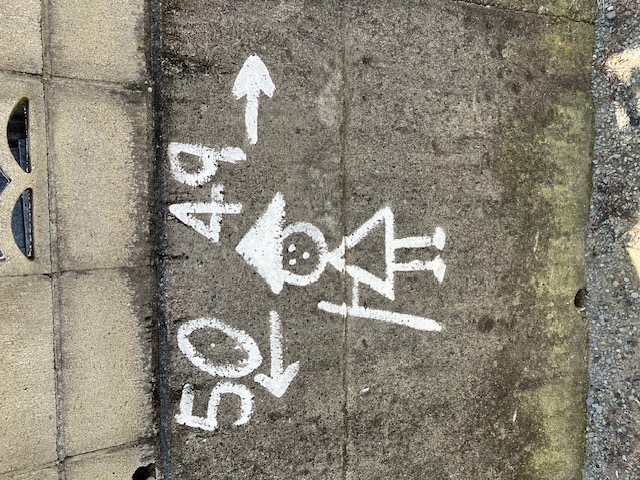
Day 33 - May 18 (31km)
I've stayed at a Toyoko Inn perhaps 25 times in my life, and they all follow the same recipe. This is a good thing, it means it always feels like a familiar space, even when you've never been to that location before.
On the tram to the main station I met a married couple with the rare last name of "Yoriguchi". Apparently they had lived in America for a year and were able to speak some English. We ended up getting the same train up the coast, and we chatted until I got off at yesterday's checkpoint, Mitsuhama Station. It was already a bit late (by Henro standards) by this point, so I concentrated on walking. At least that was my intention - I ended up swinging by a few non-88, non-Bekkaku temples that were nonetheless on the map. I saw a good looking Ramen place next to Henjōin, but with the owner apparently ill I had to go without.
By the time I made it to Aokijizō, another marked-but-not-main temple, it was already 17:00. I had no lodging arranged and was hoping to ask the temple staff if they knew a place I could pitch the tent. I soon realized there would be no one to ask - the temple seemed mostly abandoned. Yet, to my surprise, right beside it was a seemingly new, single-room building. I peered through the sliding glass door. No one inside, but it was clean, and there was bedding folded up on shelves. My gaze fell on a paper taped to the inside of the door:
Free lodging for walking pilgrims.
A miracle. The conditions were clear:
- Call us before you stay.
- Clean up before you leave.
- No homeless pretending to be pilgrims.
I called the number, and the man on the other end gave me the go-ahead. What a lucky find.
Post-trip Addendum:
The temple sat next to a massive petroleum processing plant which hummed and glowed all night. I did manage to sleep.
There is a demographic of homeless here who pose as walking pilgrims in order to garner favour and receive free lodging. It isn't looked well upon.
People in the countryside almost always greet each other when they pass by one another. This had long since become habit for me as well, and it was this day, after my greeting was entirely ignored by someone fishing, that I came to this axiom:
A person not returning your greeting is not a reflection on you, it's a reflection on them. Greetings are to be freely given, without expectation. Nonetheless, each greeting is an offer for the other person to participate in their own humanity.
Original Japanese:
安心の東横イン。駅への市電で「寄口」と云う夫婦と出会った。アメリカで一年住んだ事 あると言う。色々と話して俺が三津浜駅で降りて旅を続けた。少し遅目だったので歩く事 に集中した。と云うものの道沿いに案外と番外霊場があったので何回か別でお参りした。 遍照院の隣のラーメンは試したかったが店主が入院中と云う事で先へ進んだ。
青木地蔵まで来るともはや十七時で奇跡的に無人の通夜堂が在った。寺に電話を入れて泊 まってよし。今日は lucky だったな。
お接待:五百円・宿泊
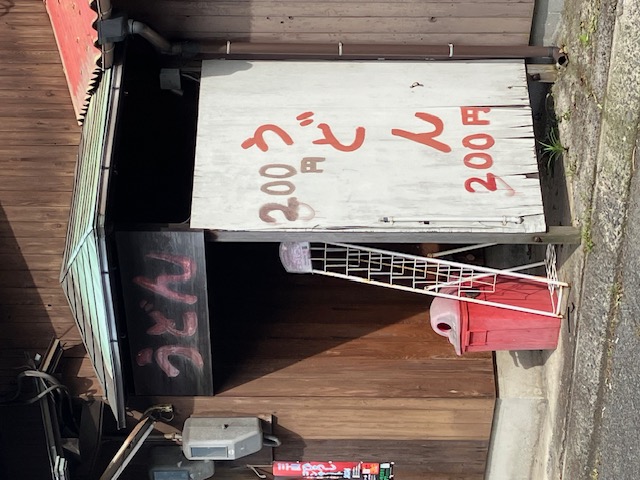
Day 34 - May 19 (35km)
I spent the day with a guy from Montreal named JC. His family lives on a farm. He's already spent two months in Japan walking and camping. I was impressed that he opted for the pure-camping approach, even in the rain. I understood once he showed me his tent: it was a special one-piece that basically can't get wet inside while you set it up. We talked much throughout the day, and it was refreshing for me to speak so much English. The past month has been mostly Japanese.
We hit 6 temples today and celebrated with an Onsen at the end. The Onsen had camping spots for an outrageous price, so we strolled the beach through the dark instead until we found a suitable place.
Animals: 2 cats
Osettai: candy
Post-trip Addendum:
It was around here that I came up with the One Minute Rule. It states:
A human can walk surprisingly far in one minute. One minute, especially where the path winds, is enough to take someone out of your sight. If you can't see them, they're gone. If they're gone, they don't exist.
Yes they exist physically somewhere, but they don't from the perspective of your subjective reality. That you can interact and be affected by someone is a decent definition of existence. So if they aren't in your personal "Interaction Zone", they're just floating out there in the Cloud of Possibility.
Who is just one minute up the road from you? Your future wife? Your best friend? The most interesting person you'd ever meet? But then you decide to take a short break and now a one-minute gap is five. Now it's an hour. Now it's a day. You'll never find them.
This is why it's a miracle that you do have people in your life. People you were never supposed to meet are nonetheless inside your bubble, and they like being there. Give them, and yourself, a chance.
But also get out there. You never know who is just one minute up the road. Would it kill you to pick up the pace?
I told this to a colleague after I had returned to Tokyo. He had this insight:
You could speed up... but what if they're behind you?
Original Japanese:
JCとの日。最初の寺で会った。 Montreal の人で家が農家。もう既に二ヶ月も日本を野宿 で旅している。一日中様々な事を話しながら寺を打った。久々にこんなに英語を喋るのが 楽しかった。
今日寺を六ケ所打ってから温泉。夜は浜辺の近くの東屋で野宿。
動物:猫2
お接待:菓子
Day 35 - May 20 (20km)
I awoke naturally before 5. It was a particularly beautiful morning. It's fortunate that my tent was bone dry, considering last night's rain.
I walked with JC again today. I asked him as much I could think of about farming and animal care. I managed to get a lot of useful information for Big Sky. What a coincidence that I should meet someone like this.
Bekkaku 10 was another "beautiful" temple, whereas 11 was "well-themed". Kūkai had apparently carved a Jizō statue into the trunk of a living tree, but unfortunately the tree fell over a few decades ago. The statue was since taken out and placed within the temple's Main Hall.
Tomorrow I'll finally reach Yokomineji (60) and the temples beyond that I visited last year with Tamayo. I have mixed feelings.
Post-trip Addendum:
I took lodging, while JC went a bit further ahead to camp by a river. My lodging was a small place called Bekku, and when signing in I learned that two people I knew had already been here: the guy who had hurt his leg walking too far, and Agata. I didn't know her name at this point, but laughed when the owner told me that a German girl with "crazy cat pants" had stayed there a few days previous.
Original Japanese:
五時前に目が覚めテントを出ると良い朝だった。テントなどが一切濡れていない。
またJCと一日歩いた日になった。歩きながら農業や家畜の世話について話した。BlueSky で使える情報を沢山得た。こんな偶然あるか。
別格十番は「綺麗」系、十一番は「テーマが興味深い」。生き木に空海が地蔵像を彫った と云う。現在は木が倒れていて像が移されている。
明日はやっと横峰寺と去年珠世と行った寺を再訪。少し切ない。

Day 36 - May 21 (27km)
A male nurse named Aoyama-san was staying at Bekku as well, and we walked together this morning until the foot of the mountain. There he turned aside for some food at a convenience store. From the lodging to the temple gate took me exactly 3 hours and I was there at 9:15. The way down felt longer. Somehow JC had beat me to the top, and he was standing near the gate when I got there. We hiked down together most of the way to the next temple, where he turned off to stop by a Mont-bell.
I visited today's temples once already last year, and I remembered them. Being alone this time made it less enjoyable.
Tonight I'm in the parking lot of Maegamiji (64). Aoyama-san slid in at 16:45 to finish off the temple just before it closed, but JC was nowhere in sight. His detour must have desynchronized us.
There was an Onsen nearby, so I stopped by there first before settling down. On the way back I talked to a man who had lived in the states for 8 years. He was selling tacos and I'd say they were genuine.
With the sun nearly set, I finally got back to the temple and began to set up my tent. I don't know how or when it happened, by a part of the single, long pole had broken, rendering the entire thing unusable. It took about an hour, but I fixed it. It required heating up the hooked tip of one of the tent spikes with my burner, bending-and-smashing it off with a rock to great cacophony, then jamming the now-straight stick of metal up the two ends of the pole to hold the connection point together. Thank god for Youtube. Also, good job man, you didn't give up. You handled it!
Animals: 3 cats, 3 snakes, 1 mamushi.
Osettai: breakfast, water, a place to sleep.
Post-trip Addendum:
I had only slept in that tent 10-15 times, and I already had a pole failure? Not at all what I wanted to happen when the sun was already down and I had no help, but I figured it out.
During my walk with Aoyama-san we had talked about what it meant to be Japanese. Japan has the somewhat rare convergence of language, culture, ethnicity, nationality, and geography being nearly entirely unified. Basically, Japanese-speaking Japonic-asian citizens of the country of Japan upon the Japanese archapelago. Yes there are dialects and yes there is something of differing cultural attitudes between the East and West, and no I haven't forgotten about the Ainu or the Okinawans, but by and large Japan is "the same" throughout the country. This instills the people with an amusing assumption that everywhere else is like that too: unified and uniform. So the contrast surprised him when I described myself as an English-native, Japan-influenced, European-descent Caucasian citizen of Canada, living in Japan, but also that there are plenty of Canadian who don't fit that description at all. For the rice-loving Japanese, to the question "So what's the staple food in Canada?", the answer "There isn't one" nearly doesn't compute. Honestly it's probably rice at this point for me.
Original Japanese:
朝は麓の辺りまで青山さんと二人で歩いた。宿から寺の山門までは丁度三時間で9:15に着 いた。下りの方は長く掛かった。また上で再会したJCと一緒だった。
夜は前神寺の駐車場。近くに温泉も在って帰りに八年もアメリカに居た男「マイ」にタコ スをもらった。
テントを貼ろうとすると、棒が壊れている事に気付いた。一時間位掛かったが修理した。 Thank god for Youtube. Also, good job man, you didn't give up. You handled it!
動物:猫3・蛇3・蝮1
お接待:朝食・水・寝る場所
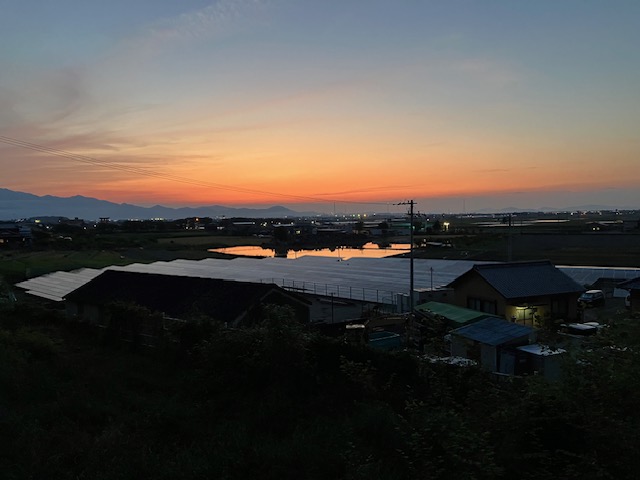
Day 37 - May 22 (35km)
The fix held and I was packed up and gone by 5:15. After about an hour I saw a tent I recognized in a long field by a river; JC. He hadn't made it to 64 the night before, but had to press on anyway for the campsite, so after we parted he headed back in the opposite direction. The resulting few-hour gap will probably separate us for good this time.
This is the last day of the trip which contains no temples and I just walk. Well, Bekkaku 12 was there, at least. The woman in the Nōkyō office helped me look up some lodging. She had offered a hut of theirs just outside, but it was still too early in the day to stop.
At some point I saw a Caucasian man asking for help outside a pharmacy. I stepped in to translate, and he told me he was looking for an electric shaver. They didn't have one, but offered directions to a bigger place nearby. We walked together for a short time until he turned right, up a wider street but off the Henro route.
Tonight I'm at a hotel in Mishima. I snuck ahead by train to reach the hotel at a reasonable time, so tomorrow morning I'll be heading back to where I boarded and walk from there. After that, it should only be a few hours up an incline to Sankakuji (65).
Animals: 3 cats, 13 monkeys, 1 baby snake.
Osettai: 500 yen.
Post-trip Addendum:
I found out later that he did indeed find a shaver. By contrast, I hadn't shaved since my haircut a month ago. I'm sure I looked like a wildman by then, but had the benefit of a distinct lack of mirrors.
Original Japanese:
修理が持ってくれた。五時十五分頃出発。一時間位経つと見覚えのあるテントを見掛けた。 やはりJCだ。彼は昨日で64番に行けなかったから一旦引き返さないと行かん。これでは はぐれる可能性が高い。
この旅最後の「ただ歩く」日。ま、別格十二番もあるが。納経所の女が宿に関して色々と 調べてくれた。
Electric Shaverが買いたくて困っている人の人助けもした。通訳の力。
今夜は三島のホテル。朝ほんの少し電車で前駅まで戻って二時間程歩くと三角寺。その後 登山。
動物:猫3・猿13・小蛇1
お接待:500円
Day 38 - May 23 (27km)
It was raining slightly as I stepped out of the hotel. Luckily it soon stopped, and I boarded my 6:30 train back to Sangawa without issue. Aoyama-san had had the same idea and was on the same train, so we walked together from there until around noon. He talked a lot and it was starting to get on my nerves.
The grounds of Sankakuji (65) were beautiful. Yet a contender for #1 of the entire journey was next: Bekkaku 13, Senryūji. It had a mountain climb to reach it, a massive main building, a main hall carved out of the mountain side, and was surrounded by slopes and deep forest. The monk also offered me water from a mountain spring. It was everything you could hope a mountain temple to be. I wish I could have stayed longer.
After that it was an ordinary descent. Houses dotted the mountain road, which sat above a dammed river. Prior to the damming there used to be other buildings further down, but they have since been swallowed by the water.
Bekkaku 14 was waiting for me down in the valley town. I liked it for its unique name, Tsubakidō, the Camellia Hall. Another 2km up the road was an official Henro Hut, my home-sweet-home for tonight. I celebrated a good day with some traditional Buddhist meat sauce pasta.
Animals: 1 baby snake, 1 cat
Osettai: Juice, water
Post-trip Addendum:
Aoyama-san and I parted at Bekkaku 13, and I didn't see him again after that. We took the same route down, but I somehow never caught up to him.
Original Japanese:
朝、外に出ると小降り。幸いすぐ止んで六時半の電車で寒川駅まで戻った。青山さんも居 たので昼頃まで一緒に歩いた。ちょっとお喋りで途中で飽きた。
三角寺は境内が綺麗でよく出来ている。しかしこの旅一番を争うのが別格十三番仙龍寺。 山登り、巨大な本坊、岩を彫った本堂、nice大師堂、豊かな自然、泉の水をくれる和尚さ ん。もっと居たかったな。
それから単に山を下った。今日は遍路小屋。
今日の backpack は今までで一番重かったが最後まで歩けた。登山はいつもより遅かった がくじける事なかった。
動物:小蛇1・猫1
お接待:ジュース・水
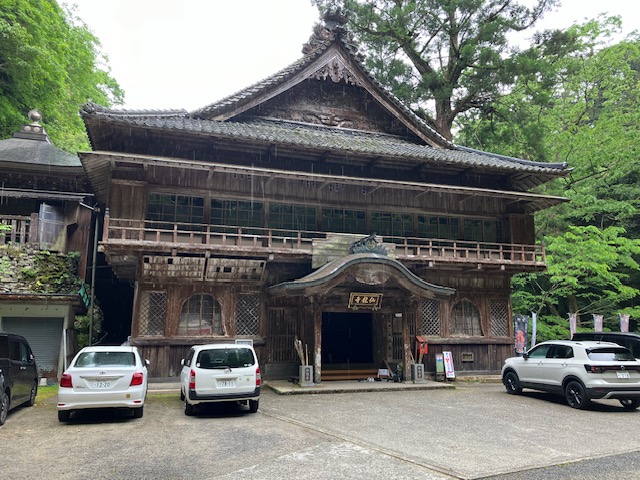
Day 39 - May 24 (28km)
Normally from the narrow valley town I stayed in yesterday, you walk a bit further and turn off to the scale the mountain to Umpenji (66), the highest temple of the route. However since I'm doing the Bekkaku as well, I followed the river back east into Tokushima Prefecture to visit Bekkaku 15, Hashikuraji. It had without a doubt the largest grounds so far.
It had a hike as well, and once up the mountain and up the first set of stairs, you find another one with each step labelled with a symbol from the Heart Sutra. You chant it in time with your steps as you climb.
Tomorrow I face Umpenji, climbing it from the back way. I will do it.
Animals: 2 snakes
Osettai: Candy, bread
Original Japanese:
箸蔵寺の日。旅一番の規模のすごい寺だな。境内が広い。明日はやっと雲辺寺。やるぞ。
動物:蛇2
お接待:菓子・パン
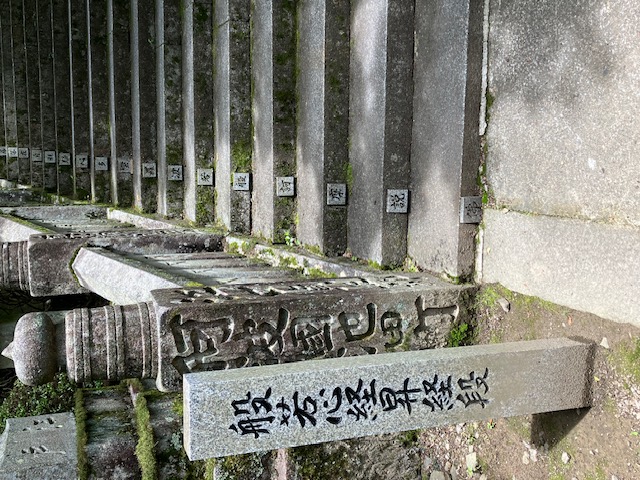
Kagawa Prefecture - Arrival
Day 40 - May 25 (37km)
I slept well. I was off by 5:30 and up the mountain by 9:30. The climb was mostly roadway, and while steep in places I was a bit disappointed.
Were I to describe the temple in one word, it would be "sanitized". There wasn't a fallen branch to be seen, and every surface that could possibly be polished was.
As I came around to the main gate, who should I spy by Tomatsu-san, the traveling monk from weeks previous. My beard had grown a lot in that time and it took him a moment to recognize me. We were both quite surprised but were glad the other was well.
I hiked back down through the mountain trails and made better time than I thought I would. I managed to hit not only Bekkaku 16, but also Daikōji (67). From there I walked another hour into the city and found a Zenkonyado, which is free lodging for walking pilgrims, managed by volunteers. On the way I had run into a fast-walking, fast-talking Australian named Julie, and I pointed the Zenkonyado out to her too. We're both there now. Thanks to Tomatsu-san for telling me about it!
Tomorrow I'd like to stay at Zentsūji (75) if I can.
Animals: 2 snakes, 2 cats
Osettai: Candy
Post-trip Addendum:
Considering the One Minute Rule, to have run into Tomatsu-san again like this was quite unlikely. But ever since Kōchi we had a way of bumping into one another. I was grateful to have a brother-in-arms of sorts.
While it wasn't at the forefront of my mind at the time, the arrival at Umpenji meant I had crossed into Kagawa Prefecture, the last section of the journey. Given that I had something I couldn't miss on June 4th back in Tokyo, I was starting to worry if I'd finish on time. I had basically one week left to finish everything, including a final trek to Kōyasan.
Original Japanese:
快眠。五時半出発で九時半に雲辺寺に着いた。登りは殆ど路上だった。寺を一言で描写す ると、清潔。境内のよく磨き上がっている寺だ。
山門に廻ると何と戸松さんも居た。数週間ぶりだ。彼も再会で驚いていた。
後は中々計画よりかなり速く進んでいて大興寺も廻れたし、その一時間程先の善根宿まで 歩けた。途中で Julie と云うオーストラリア人と一緒に歩くようになって宿が同じ。教 えてくれた戸松さんに感謝。
明日善通寺に泊まりたい。
動物:蛇2・猫2
お接待:菓子
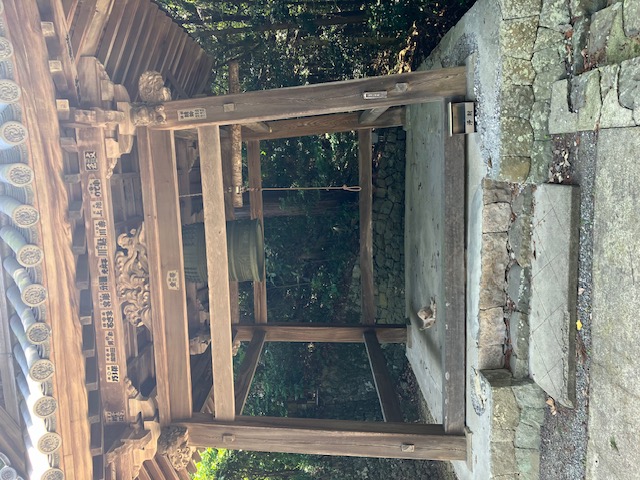
Day 41 - May 26 (37km)
Another record-setting day, but for temple count, not distance. I was active for a full 12 hours and reached 9 temples. I had left the Zenkonyado by 5:30, and completed the final Nōkyō at Zentsūji at 16:55, right on the line. They closed up all the inner buildings immediately afterward as I rested on a bench, savouring the day.
To my lodging was another 2km or so. I bathed and promptly patronized the all-you-can-eat Yakiniku nearby. A little early for a Yakiniku celebration, but hey, I kicked ass today. Was damn hot though.
Iyadaniji (71) was oddly derelict for such a frequented temple. Nearly broken-down shacks and small halls were throughout. Zentsūji, being the head temple of a certain subsect of Shingon Buddhism, was appropriately vast. I had arrived at 16:45, sped to the Nōkyō office to say "I'm starting my rounds now!" (as in, please don't close), to which they said "Well you better hurry." I did, which I regret, but the Yakushi Nyorai in the Main Hall was giant, imposing, and impressive.
Animals: Vast counts of turtles, 3 cats
Osettai: Donuts
Post-trip Addendum:
Walking alone in the morning is a treat. With the world mostly still sleeping, you get a good hour or two of solitude and peace. Unfortunately I found the dual-temples 68/69 too quickly, and had to wait some time for the Nōkyō office to open. At around 7:00, an hour earlier than usual, a young monk came out and told me he'd sign my book. Thank goodness he did, or I never would have made it to Zentsūji on time.
Speaking of which, I wasn't able to stay there. Yet another "sorry, we're full" when I called. Of course it's always better to call well in advance, but we take the Henro day by day. I should have stayed a bit longer to wander the grounds more, but I had rushed in and I rushed out. This was actually Kūkai's birthplace, and he got his revenge for my haste, as you'll see later.
As I write this follow-up, I'm reading a book by David Goggins where he describes running 100-mile (and then 240-mile!) marathons in a single stretch. And here I am celebrating a mere 37km. I could make excuses like "well I have a 10kg pack" or "I've been on this pace without a break for two weeks" but it doesn't feel right. Am I strong or weak? I'm certainly not weak. The only thing to do is to see what's next for me.
Original Japanese:
また記録的な日。一日に九ヶ寺。十二時間活動の日。出発したのは五時半頃、75番で納 経したのは4:55。その後も宿まで数粁歩いた。頑張ったな。褒美として焼肉。少し早いが 今日は頑張った。しかも暑かったな。
弥谷寺は意外と衰退状態やった。半分壊れた小屋や堂が多かった。善通寺は総本山なりに 広かったが少しがらんとしていた。しかし本堂の薬師如来は巨大で印象的だった。
動物:亀、多・猫3
お接待: Donuts
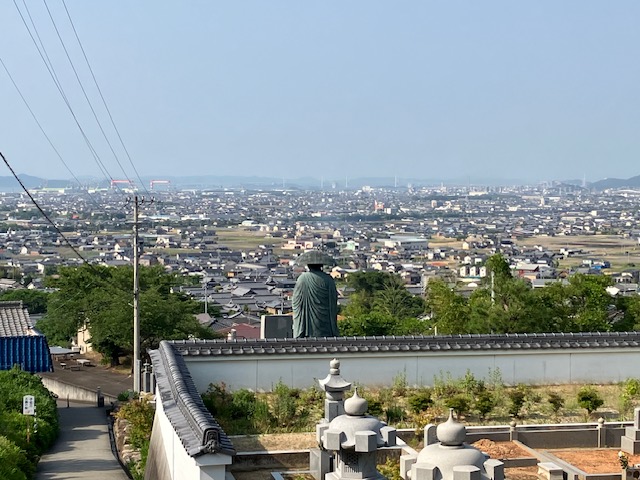
Day 42 - May 27 (30km)
One reason that the Bekkaku are Bekkaku is that some of them are quite out of the way. Bekkaku 17 is one such, so instead of a light, 30-minute walk to Temple 76, I took the opposite direction, south, for several hours to Kannoji. It was raining when I started but it let up after an hour or so. The temple itself was quite small, perhaps the smallest on the entire route. And it is dwarfed even more by what it stands beside: Lake Mannō. It's technically a made-man water reservoir and the Japanese word used is "pond", but any sensible person would know it's a lake. Everything was still - there wasn't a ripple on the entire surface of the water. There were tables nearby so I took a break. A stray cat joined me, and while I thought I had nothing to offer, I remembered my tuna can and dished out half for her.
The way back was just a repeat of the way in. Most of the way to where I started the sun came out and the humidity skyrocketed.
At the last temple of the day, I spoke with a Korean traveler in English. He had been visiting the nearby temples as well, both on foot and by transit, but would be heading home in a few days.
Tonight I'm in an older hotel by a train station. Tomorrow it's supposed to pour.
Animals: 2 cats, hordes of turtles
Osettai: Water
Post-trip Addendum:
It was around here that I had a subversive thought:
This is getting too easy.
Original Japanese:
別格の為、南に直進。最初は雨に降られたが一時間位したら止んでくれた。寺は小さかっ たが近くの満濃池は池と云えども湖の様だった。波は全く立っていなく静かな休憩を野良 猫と一緒に過ごした。やる餌はないと思ったら缶鮪を思い出して半分位やった。
帰りは来た道をまた辿るだけ。途中から蒸し暑さが始まった。
最後の寺で韓国の観光客と少し英語で話した。彼も寺を廻っているが交通機関も使って後 数日で帰国すると言う。
今夜は駅前の古目のホテル。明日は大雨らしい。
動物:猫2・亀、多。
お接待:水
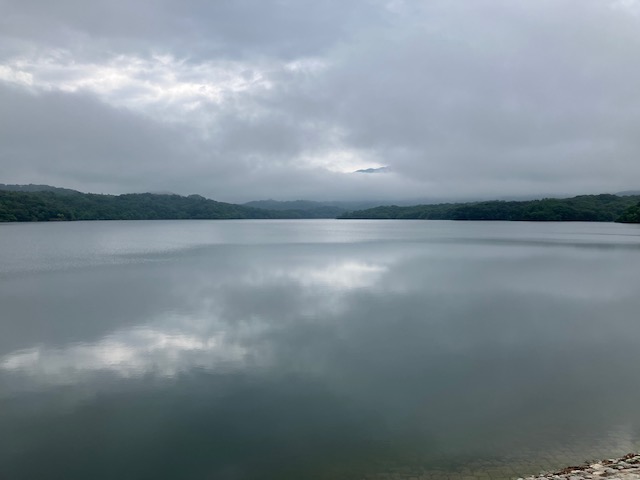
Day 43 - May 28 (34km)
The first hurricane of the season was tearing past the bottom coast of Shikoku, and its effects were far-reaching enough that it poured most of the day today even here in the north. As I left the hotel at 6:00 it was already raining.
An hour in and my boots were already wet inside. I recalled that soaken day back in mid-Kōchi and knew I'd be alright, even with hours of wet-foot walking. Most cars and trucks were considerate and dodged the gathering puddles in the ruts of pavement near me, but some were not. I got full-on splashed once, and I was more wary after that. I had lunch at a convenience store, a good chance to strip my drenched gear, but soon it was over and I was back out in it. The best way I found was to just count to 3 and jump out into it without too much thought. It's the thought that convinces you to stay where it's dry, even when you shouldn't.
Eventually I reached the area of Temple 80, the final Kokubunji of the pilgrimage. I'd get through here quickly, and then climb the mountain behind it for the final two temples of the day. I saw some cars near a back gate in what was labelled as a temporary parking lot, so I pressed on, trying to wind my way around the walls in search of the entrance. The little red Henro stickers I had been relying on for all these weeks also pointed me forward, so on I went. I found a man walking and asked him where the entrance was. He told me to keep going until I hit the next crossroad and then turn left. I did so, but no obvious entrance was to be seen. Okay. Seeing what were obviously temple buildings now off the left, I kept winding my way around, now snaking through side streets lined by the houses of locals. No temple entrance. I had come a full 180 degrees from where I started, and eventually got fed up and jumped over a small ditch into a field. Evidently these were the grounds of "old Kokubunji", the original land of the temple as it stood 1300 years ago. I sloshed through the spongey field, back in the direction I had come from. Where was the damn entrance!
I eventually found a museum of sorts for the site, and asked the women inside where I should head. One of them walked back out into the rain with me to show me the way, but when I got there, it was the back gate I had seen 20 minutes ago. What? Upon closer inspection, a sign on the gate announced that they were closed. A Henro temple closed, in the middle of the day? I had never heard of such a thing, so I called the temple and explained my plight as a walking pilgrim. The man on the other end was insistent: he could not guarantee the safety of visitors on a day like this, so the gate was shut. Protecting the public was his duty. Should there be an injury, that would surely bring down the media on the temple, and we couldn't have that, could we?
I was stunned. I protested, but he would have none of it. Mind you, I could see the inside of the grounds from where I stood; it was flat ground. Injure myself? Seriously? Sure it was raining but this was no Shōsanji. Finally, he invoked his religion, saying it was the will of the Buddhas that he keep the gate shut to protect the people. Evidently "protecting the people" did not include aiding a soaked pilgrim. I hung up, furious.
My anger propelled me up the mountain and I made great time on the trails. Some parts were entirely washed out, the trails having become rivers and waterfalls. The challenge was exhilarating. Right before Temple 81, a waterfall had formed off the mountainside and over the road I had come out onto. The gate to the temple was just beyond, so I tried to jump over. Having foolishly thought I knew what a wet boot was, I now knew intimately. Ironically, this temple was open, although there was not a soul in sight. The young man in the Nōkyō office was friendly and helpful, but alarmed that Temple 80 below had been closed.
I hiked back the way I came, headed straight at the fork, and eventually came to my lodging for the night, a Zen training centre not far from Temple 82. There was a familiar face there when I arrived: Agata of the Cat Pants. We talked at length about Big Sky; it was a great opportunity for feedback.
Original Japanese:
雨の日。国分寺の入口が中々見つからず、人に訊いたらさっきおった所やないか。只門が 閉まっている。寺に電話すると参拝者の身の安全を境内で保証できないので門を閉めてま すと云う訳分からん事言われて暫く言い争った。が、結局駄目だった。怒りの力でその後 山登りをしていいペースで81番に辿り着いた。山道が川や瀧になっている所も有った。 難度が高くて楽しかった。
夜は82番の近くの禅道場。なんと猫ズボンドイツ人の Agata も居た。 Big Sky の話を した。
Day 44 - May 29 (26km)
I tossed and turned through the night, constructing the speech I'd dash upon Kokubunji the next day about how irresponsible they had been.
Zazen started at around 6:00 and lasted about 40 minutes. Having not sat for weeks it felt great. Breakfast was porridge, and although it wasn't enough I couldn't say that out loud. I left with Agata around 8:00, the sky above a beautiful, clear blue. After Temple 82 we split up; I was heading down the mountain the other way in order to hit Bekkaku 19.
I must have missed a turnoff somewhere, because I got lost and had to ask for directions from the locals three times before I finally found the temple. The old man in the Nōkyō office was calm in his years, and he reviewed with me some points of ettiquette when addressing the Buddhas at the Main Hall. I asked him if they had been open yesterday, and he said yes without hestitation. He shook his head when I told him what had happened. "I've even heard some temples on the route are starting to charge entrance fees" he said with sadness. I had neither seen nor heard of such a thing all these weeks, so wasn't sure what to say. Afterward I took a train back around the mountain toward Kokubunji. This wasn't cheating, as I'd be walking to 83 from there and the overall distance would be the same.
Time for a fight. I was ready. With not a cloud in the sky, the gate was wide open. I stepped through and noticed another small sign, different this time.
We ask a 200 yen entrance fee for all visitors to the temple.
I sighed. So that's what all this was. Within the grounds itself were golden statues and large signs promising salvation from suffering. Inside the Nōkyō office were pilgrimage products galore, one of the biggest displays I'd seen on the entire route. I walked to the desk and first took care of business, paying the usual 500 yen for the temple's official recognition of my passage. Then I asked, "Excuse me, is the Abbot available? I have an official complaint." The two elderly women looked at each other with troubled expressions. One turned back to me, "I'm sorry, he's not here right now." So much for my speech! "Okay, then where is he?" To which she replied, "He's at the bank and won't be back for some time."
I strolled out of there with a smile on my face, satisfied that the universe had delivered. The sheer irony made my troubles from yesterday worth it. Good luck, Sanuki-Kokubunji! And I got the last laugh; I didn't pay their damn entrance fee.
At Ichinomiyaji (83) I ran into Agata again. Despite my detours I had somehow gotten there ahead of her. We walked into the city centre together then parted ways for the last time. Dinner was Kushi-katsu.
Animals: 2 cats
Osettai: Candy
Post-trip Addendum:
It is absolutely unheard of to charge an entrance fee at a temple. It's also unheard of to close the gates in the middle of the day, especially to pilgrims, regardless of the weather.
Original Japanese:
夜中、国分寺に言い付けてやる言葉を考えていた。座禅は六時頃から四十分ぐらいだった。 久々にやって気持ちよかった。朝食は粥だった。足りなかったがそんな事言えん。出発は 八時頃で青天。八十二番を打って Agata と別れ、別格19へと向かった。どうやって迷っ たか分からんが地元の人に三、四回道を訊いてやっと辿り着いた。納経所に居たのは年配 の男性で彼は丁寧に拝む作法の事を教えてくれた。その後は電車で国分寺まで戻った。因 みにこれはずると認識しない。
いざ闘い。まず門の所に200円の拝観料を請求していますと書いてある知らせ版が目に留 まった。寺に入っただけで拝観料?境内に入ると金箔に覆われた仏像だったり仏教を商売 の対象にしている看板が在ったり、この寺はもはや心配と思った。納経所に移ると売り物 がこの旅一番位置いてある。まず納経していつもの500円を払う。そして「住職はいます か?正式な苦情があります」。奥に居た二人の高齢女性はお互い目合わせて懸念の表情を 見せる。「すみません、住職は今居ません」。一気にあーと云う気持ちに。俺のスピーチ はどうなると思いながら「どこに居るんですか」と訊く「銀行です」、そして「暫く帰っ て来ません」。こんな皮肉な事有るか。気持ちが晴れて寺を後にした。このネタを手に入 れたので昨日の苦労は worth it になった。頑張れよ、讃岐国分寺!最後の抵抗としては 拝観料も払っていない。これも因果。
一宮寺で Agata と再会。市街まで一緒に歩いてまた別れた。
夕食は串カツ。
動物:猫2
お接待:菓子
Day 45 - May 30 (20km)
I was to stay with friends tonight and their town wasn't that far away, so I was in no rush today whatsoever as I walked. There were two minor mountain climbs, and I found both temples peaceful and proper. In the valley between the two was a smaller temple that housed the grave of Shinnen, the monk who formalised the pilgrimage route during the Edo period. I teared up when I saw it. It was written there that he had completed the journey over 20 times during his life, and that was hundreds of years ago before any of the modern luxury I have been enjoying. Had not waves and waves of pilgrims through the ages opened up the way for me, I'd never be here walking it.
I arrived at Toshiyuki-san's place around 13:00 and am currently relaxing. The dog and I are watching the news. Only two temples remain; tomorrow I will complete the main pilgrimage.
Osettai: Lodging, dinner.
Post-trip Addendum:
Tomatsu-san was at the first temple of the morning. We talked again briefly before parting ways, once again sure we'd run into each other again. We didn't.
戸松さん、あなたは遍路仲間で一番長い付き合いでした。ありがとうございました。これ からの修行も、頑張って下さい。では、またどこかで。
Original Japanese:
割と楽で急がない一日。軽い登山は二回、寺は両方平和でちゃんと仏教をやっている印象 だった。十三時頃に敏行さん達の家に着き、寛いでいる。番犬と二人でニュースを見たり。
そう云えば真念の墓も訪れた。涙も出た。彼は巡礼を20回果たしたと云われている。多 数の人間が道を開いてくれなかったらこの旅できなかったな。
お接待:宿泊・御飯
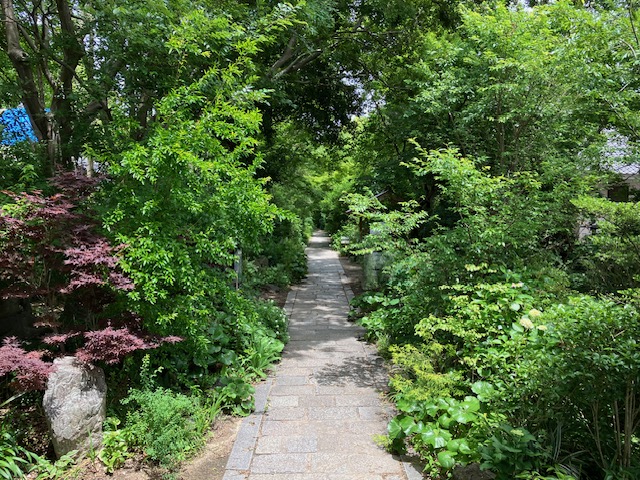
Day 46 - May 31 (23km)
The day of completion. I woke up and gathered my things. Takako-san woke up early for me too to make breakfast. At around 6:00 Toshiyuki-san also appeared and we said our goodbyes. Then I was off. Too bad it was raining on this day of all days, nor did it stop until around 15:00.
The Niō statues at the gate of Nagaoji (87) had great facial expressions, but the temple itself was ordinary. On my way out I ran into Julie again.
The climb to the final temple was far less extreme than I had expected it would be. By this point the rain offered no challenge, it was little more than an inconvience. At least at the Henro Salon I was able to learn some more history of the pilgrimage, and the staff awarded me with a Certificate of Completion. I'm #1620 since April of last year. Every year several thousand people complete the journey on foot, and several hundred of those are from overseas. It's actually more than I thought.
The Niō gate at Ōkuboji (88) takes the crown for the entire route. It was massive and the statues were immaculate. Once within the grounds, I found the temple a solid "good". Not my favourite, but good. After completing the rites and getting the final signature, I called my dad to tell him the good news. Julie also showed up and we took each other's pictures. The bus back down wasn't due for a while, so I sat out of the rain and ate the lunch that Takako-san had packed me. When it finally came, I was the only rider, and the young driver really hauled ass on the way down.
I write this on the ferry to Wakayama. Tomorrow I climb Kōyasan to report my completion to The Man himself.
Post-trip Addendum:
I found the ending of the main route anti-climactic. Luckily, the next day made up for it.
That was the last I saw of Julie, who elected to walk down.
Original Japanese:
結願の日。朝起きて荷物の準備をした。多佳子もすぐ起きて朝御飯を作ってくれた。六時 頃に敏行さんも出てきて別れの挨拶をしてくれた。それから出発。生憎雨が降っていて三 時頃まで止まなかった。
長尾寺は普通な寺だった。仁王の表情はよかった。出る直前に Julie と再会。
次への登りも驚く事はなかった。へんろサロンで遍路の歴史を少し知り結願書ももらった。 去年の四月から千六百二十号目との事。毎年数千人が歩きで全寺廻るらしい。異国人で数 百人。決して少なくはない。
大窪寺自体は仁王門がこの旅一位。後はやや nice 寺だった。一番の好みではないが。結 願したらお父さんと話した。そして多佳子さん作の弁当を食べながらバス待ち。
今はもう和歌山行きの ferry に乗っている。
知り合いの家に着いたら御飯。もう十時頃。明日はとうとう高野山。
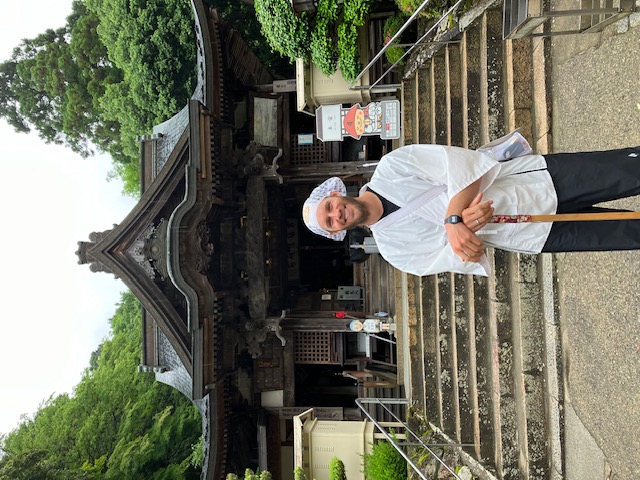
Kōyasan
Day 47 - June 1 (25km)
Wakayama prefecture is mostly a mountain range, and Kōyasan itself sits in the middle of it. Consequently there are any number of routes up to it, depending on your departure point. I chose one of the north routes, and started from a temple called Jison-in. The first section was steep but once into the pass it levels out, and the rest of the hike could be called more of a mountain walk than a mountain climb.
A few kilometers in I reached a fork where a small sign was posted, telling hikers to detour several kilometers out of the way due to an "impassible trail". We'll see about that! I pressed on and soon found what they were talking about: a minor landslide had thinned out the trail a little bit, but clearly many other hikers had already improvised a workaround before me. I got past without issue. Yes, if you were 80 years old and drunk in a rain storm, there may have been cause for worry at that particular point. But not for an adult with their head still attached.
At 11:45 I reached a small rest area and took a longer break, giving my family a call. Up the path again and in somewhat familiar territory I found yet another sign telling me to turn off and walk the highway instead. This was also ignored, but this time the way had been truly taken out by trees, dirt, and large cement blocks from road construction up the hillside. So naturally I snaked over this too. It wasn't hard for someone with climbing experience.
The path suddenly turned to switchbacks, and before I knew it I had completed the climb and the Great Gate stood before me. A smile lit my face. I made a quick pass to Kongōbuji, which is technically the head temple of the whole place (and the whole sect), but the rites are to be done and stamps to be received at the Oku-no-In, Kūkai's final resting place. It lies within the depths of a vast, forested cemetary, and houses gravestones of many of Japan's historical greats. At one point you pass a bridge, after which no photography is allowed, and conversation should be minimized. Why? Because Kūkai sits in eternal meditation within an inner chamber. They still feed him twice a day.
I didn't tear up when it was over. I was simply happy. The man at the Nōkyō office spoke to me for several minutes about my journey, and shook my hand as he congratulated me, which is rare for a Japanese person. But I was glad, because I knew he understood what I had done.
On the way back I stopped by Fugen-in, one of the many sub-temples that dot the mountaintop. A monk came out when he heard my boots on the gravel, and after explaining my situation he brought me into their Main Hall to see their Fugen statue. No temple on the Henro route venerates Fugen, who is my Zodiac-associated Buddha, but I knew from asking around that there was a single one atop Kōyasan. I performed the rites, and on the way out the monk gave me a keychain of their temple to remember the experience by.
Tomorrow I need not walk.
Original Japanese:
知り合いに送ってもらって慈尊院と云う所から登山口に入る。最初は急だが一度峠に入れ ば山登りと云うより山歩きになる。通行止めはあったが突破。11:45頃に矢立に着いて長 目の休憩を取った。その後もまた通行止めあったがここも突破。 Climbing 経験者ならど うって事はなかった。
上に上がるといきなり大門が目の前。思わず笑う。金剛峯寺も寄り、奥の院も相変わらず 別次元の様な雰囲気を漂わせる。
泣く事はなかった。只嬉しかった。納経所の人も数分話してくれておめでとうと言い、握 手もしてくれた。帰りに普賢院にも寄り、事情を説明したら本堂に上げてもらった。お守 もくれた。
明日から歩かんでいい。
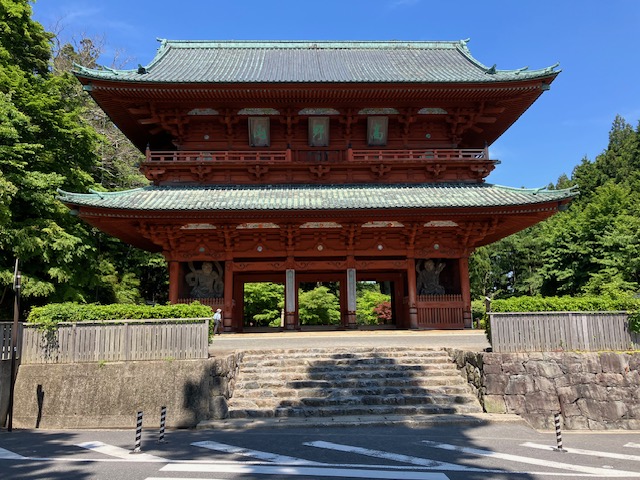
Conclusion
The benefits of the pilgrimage were multifold. It showed me what I, and humans in general, are physically capable of. It focused my goals and next steps. It introduced me to new ideas and philosophical avenues. I interacted with hundreds of people. I got turned down for lodging over the phone in Japanese over and over again. I saw the beauty of Shikoku in the Spring. I had extended exposure to hands-on Buddhist practice. I was alone with myself and at peace for weeks on end. I learned what "early" is. I learned what "wet" is. I learned what "far" is. I overcame something hard.
Not once did I consider quitting. I'm going to take that as a sign of strength.
Statistics
Distances
| Walked Distance | 1265km |
|---|---|
| Walking Days | 45 |
| Rest Days | 2 |
| Shortest Day | 16km |
| Longest Day | 47km |
| Average Distance per Day | 26.9km |
| Average Distance per Walking Day | 28.1km |
I reached all of the Bekkaku Temples except 1, 2, 3, and 20. The first three were before I had decided to do them, and 20 was beyond my time budget. This gives me a reason to return.
Lodging
| Style | Times | Total Cost | Average Cost |
|---|---|---|---|
| Inns, hotels, etc. | 25 | 121,730 | 4,869 |
| Camping | 16 | 3,820 | 239 |
| Friend's House | 3 | 0 | 0 |
| Temple (Tsūyadō) | 2 | 0 | 0 |
| Temple (Shukubō) | 1 | 4,000 | 4,000 |
| Zenkonyado | 1 | 0 | 0 |
| Total | 48 | 129,550 | 2,699 |
Roughly half paid lodging, half near-free camping. I should have been able to achieve a cheaper average for paid lodging, but I often threw in the extra for cooked meals. Those were always much better than the inevitable, half-plastic convenience store meals that otherwise awaited.
Animals
| Animal | Count |
|---|---|
| Cats | 93 |
| Monkeys | 26 |
| Snakes | 16 |
| Hornets | 3+ |
| Mamushi | 3 |
Also untold numbers of turtles, frogs, crabs, and various birds. I was hoping to break 100 for cats.
Home Again
I complete this series on July 23rd. It has been about 7 weeks since my return. In that time I have maintained my morning routine and put around 80 hours into personal projects. I am well on track to soon begin my next major undertaking, Big Sky.
JC was recently back in Tokyo for a few final days before returning to Canada, and we met twice for dinner. He had bought a special mechanical Japanese toilet seat to take back with him. Anyone who has been here and experienced that shining ivory would understand why. His pilgrimage had been fruitful too, and he was over-ready to get back to life with his newly focused mind.
This past weekend I cycled around Tokyo to visit the Edo 33 Kannon Temples. I fear this trend may continue.
Thank You
I could not have started this journey were it not for the effort and struggles of centuries of past pilgrims before me. Thank you Shinnen for formalising the route in the 17th century. Thank you Kūkai for risking death on the sea voyage to Tang China, and bringing back what you learned there to keep Vajrayana alive.
I could not have completed the journey without the day-to-day help and support of hundreds of strangers and fellow pilgrims.
Thank you to everyone who fed me.
To my family and friends who waited all week for my Mondayly updates: thank you for your patience.
Thank you to my employer, who took a bet on letting me take that much time off.
Thank you to everyone who followed along as I posted these entries here and on Mastodon.
北川家と栗原家へも、いつも仲間で居てくれてありがとうございます。
Thank you to me for taking every step.
南無大師遍照金剛